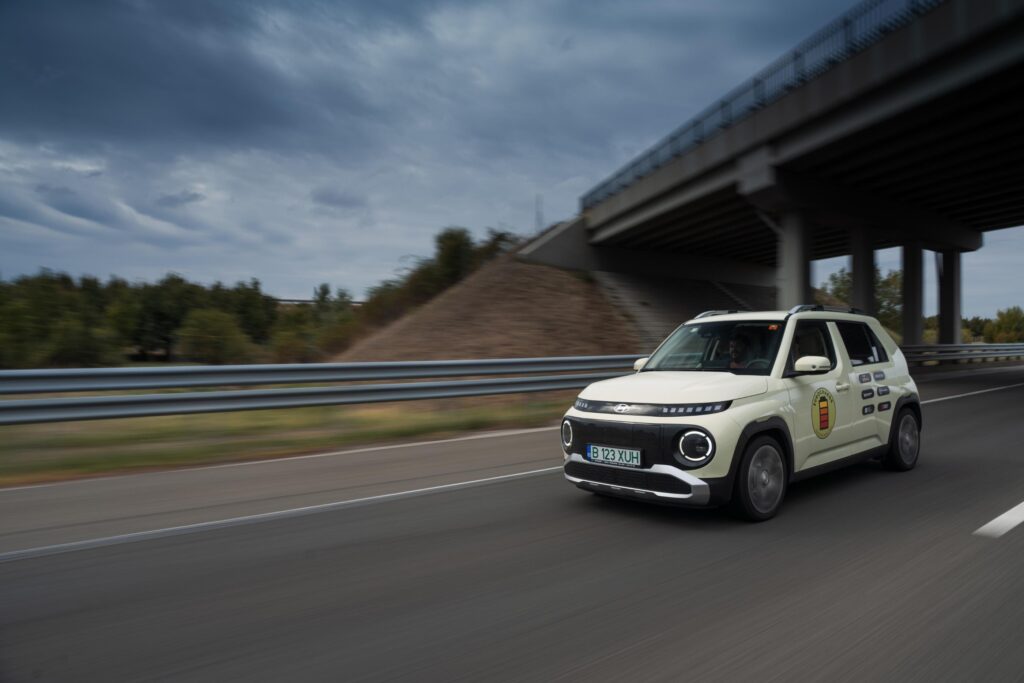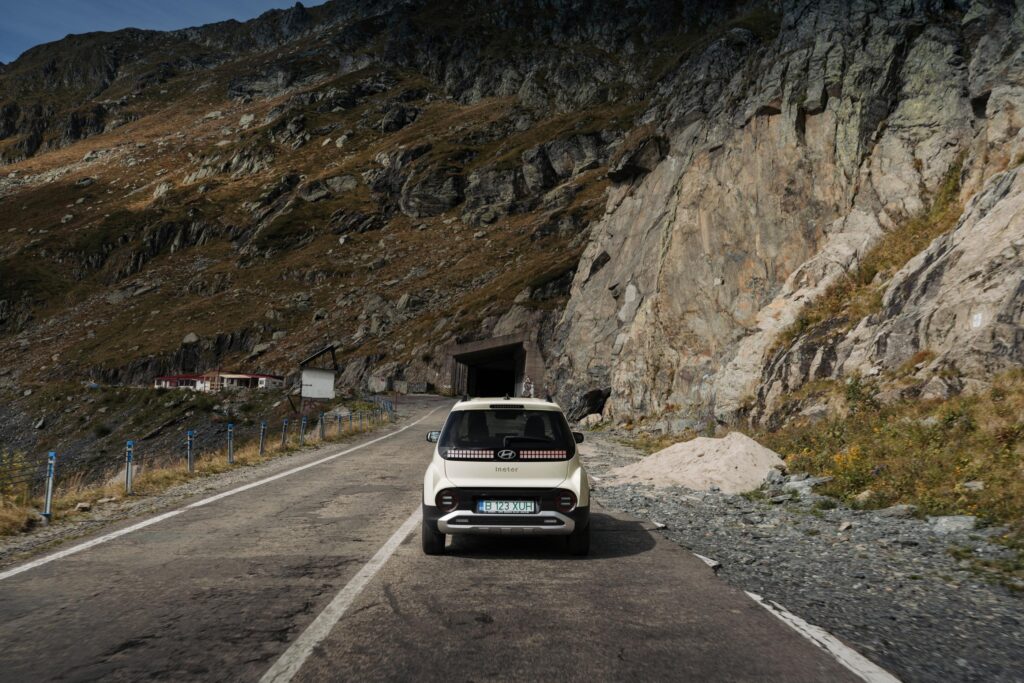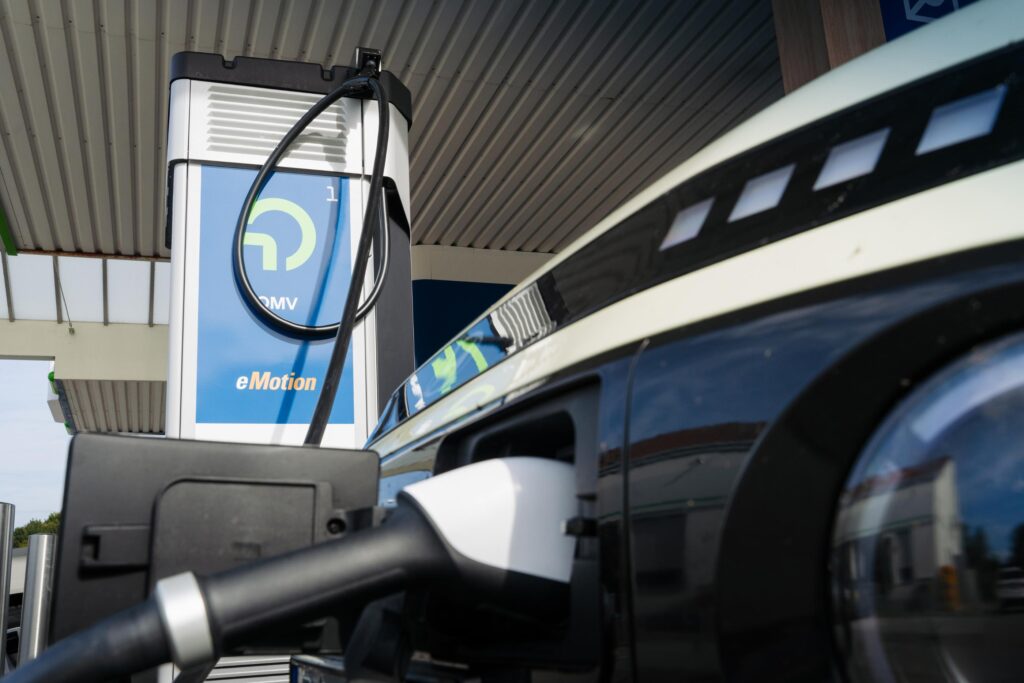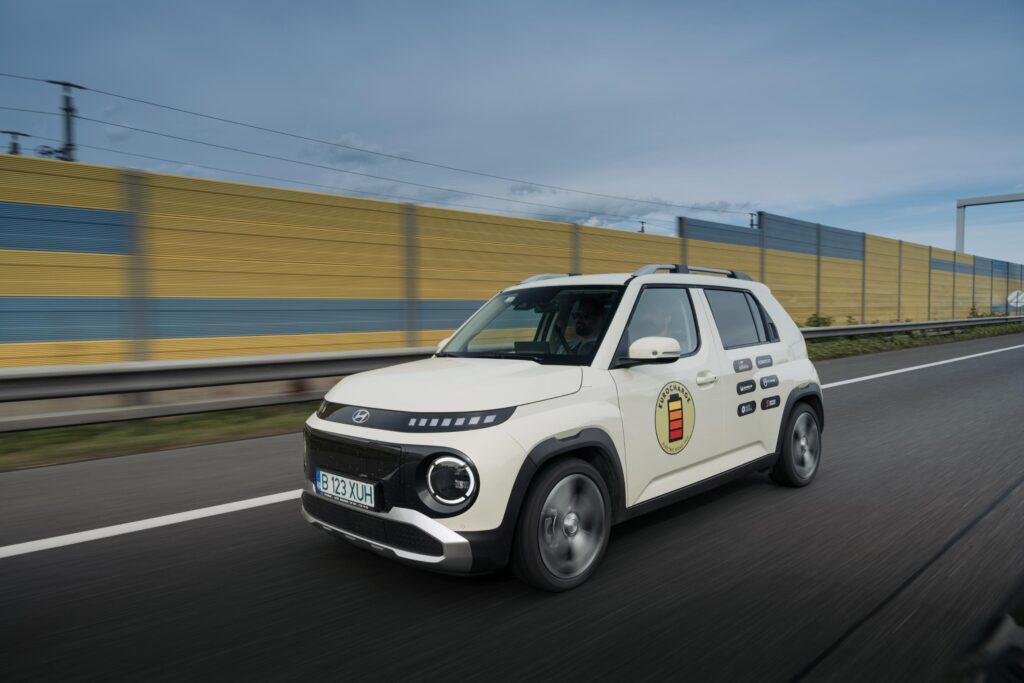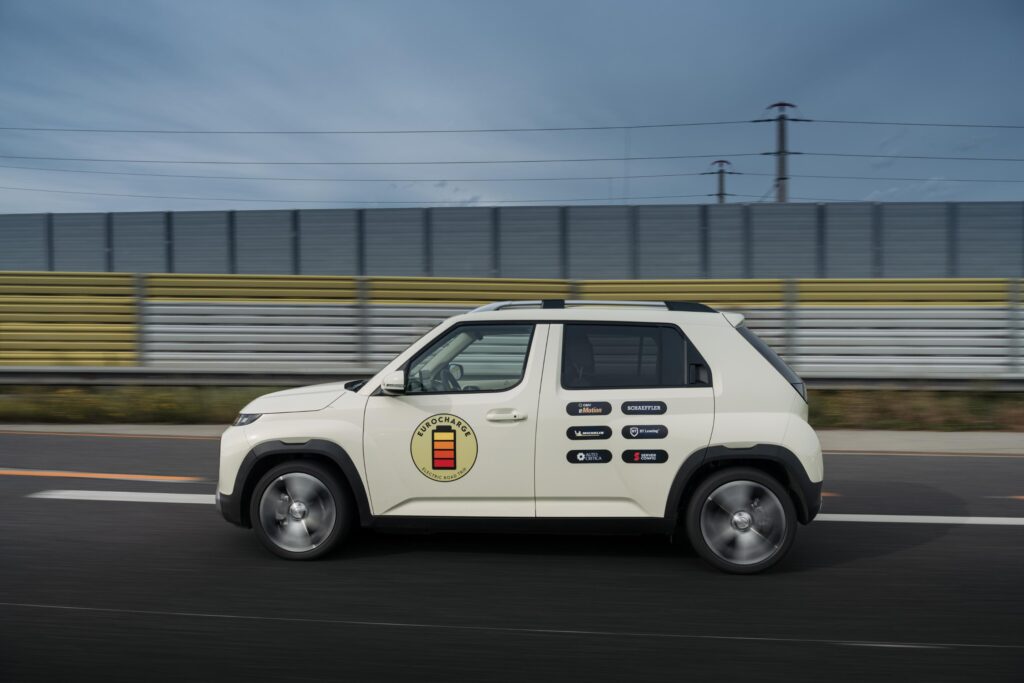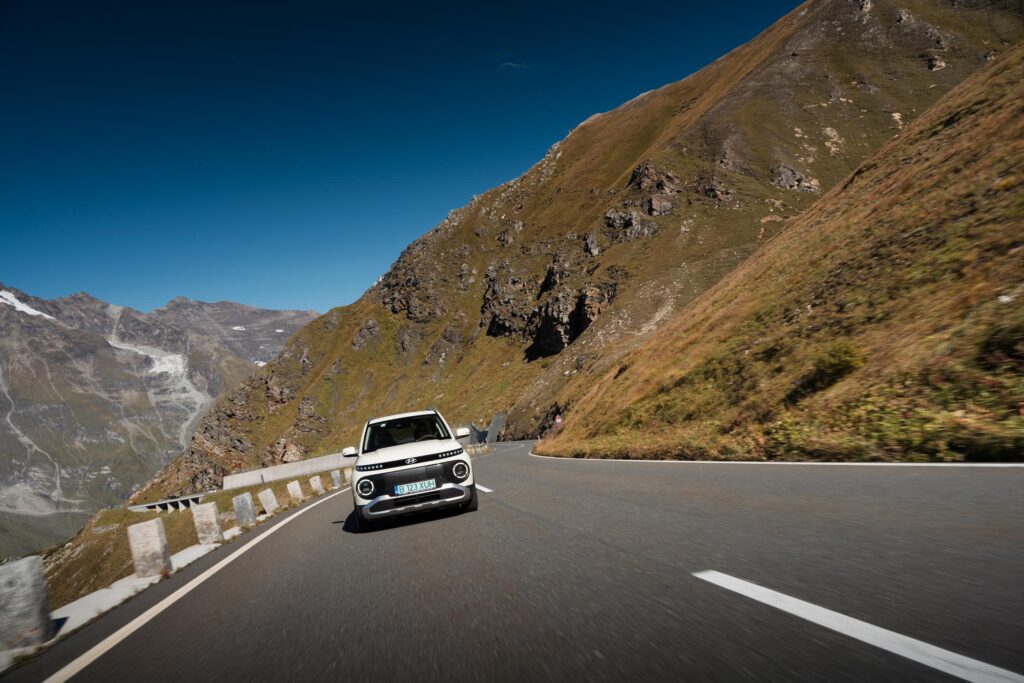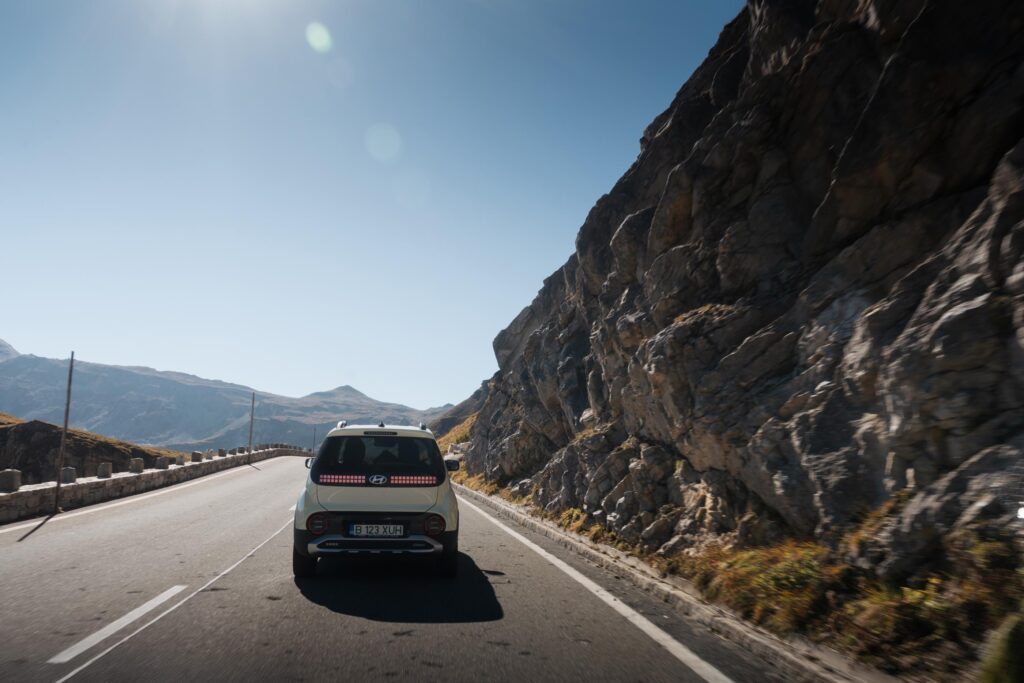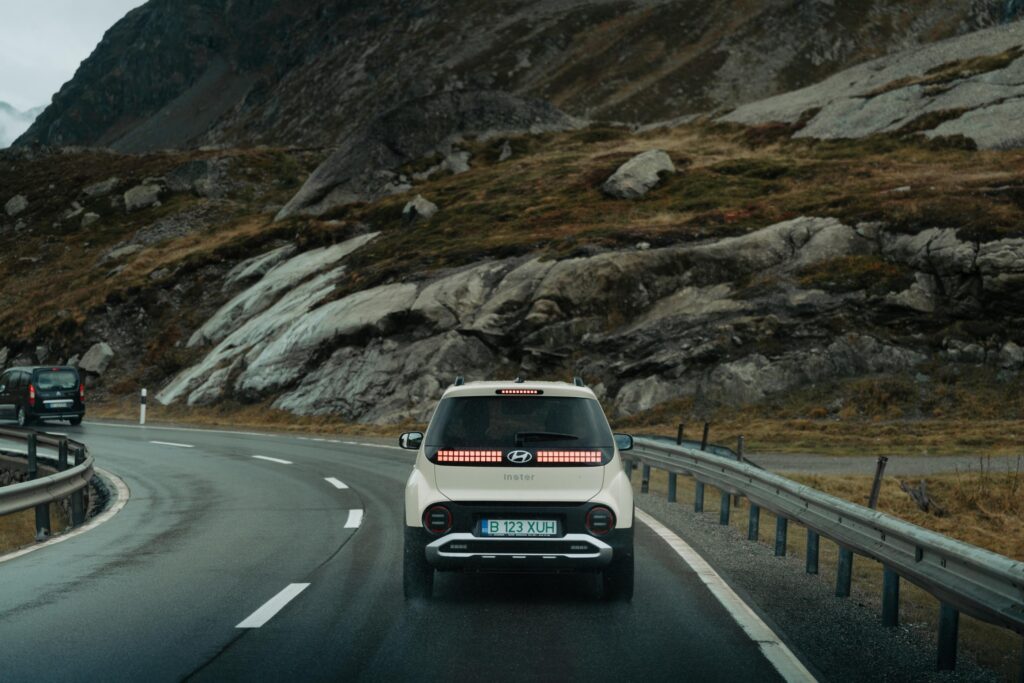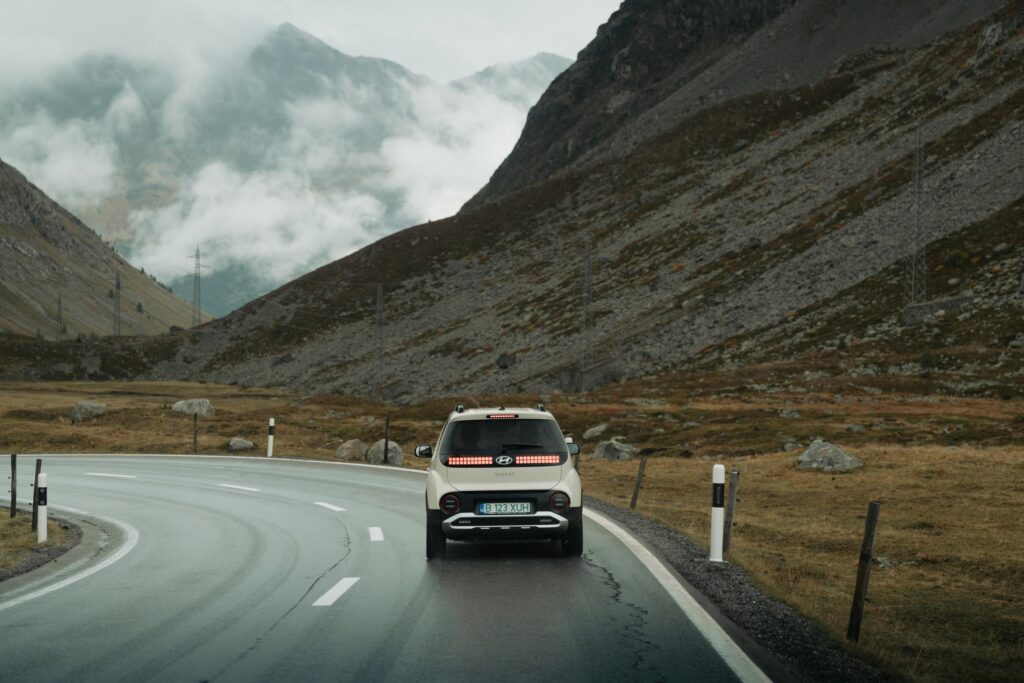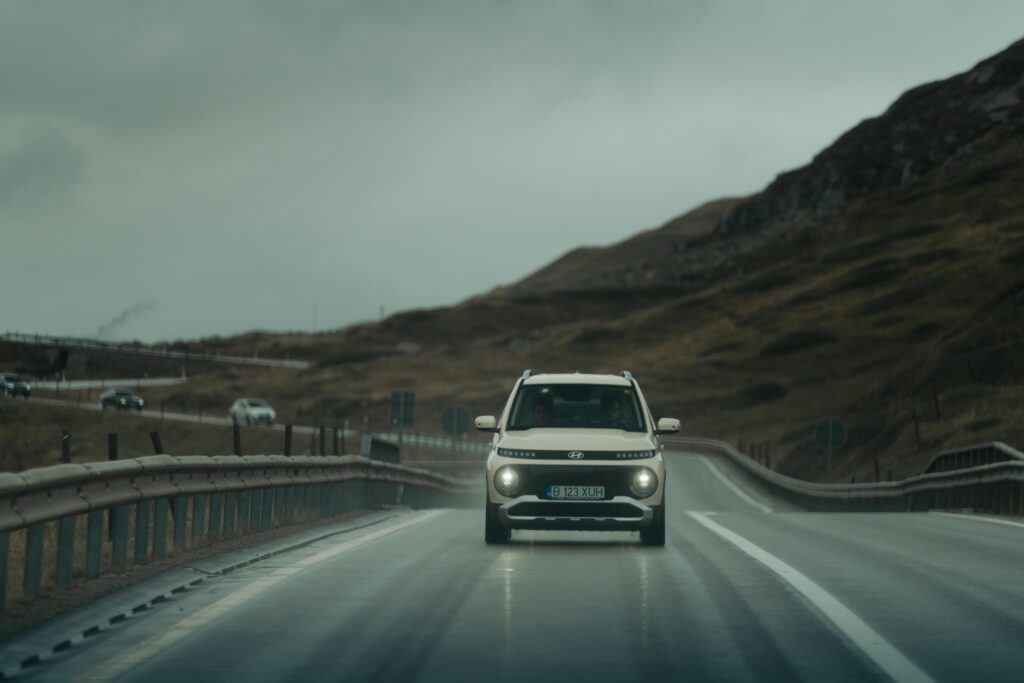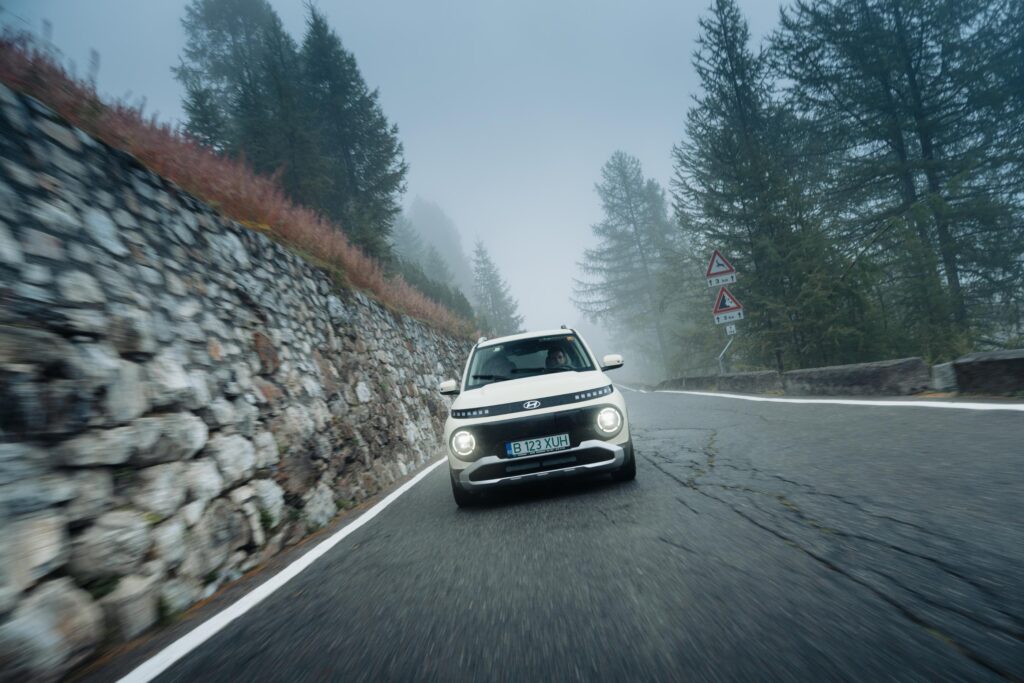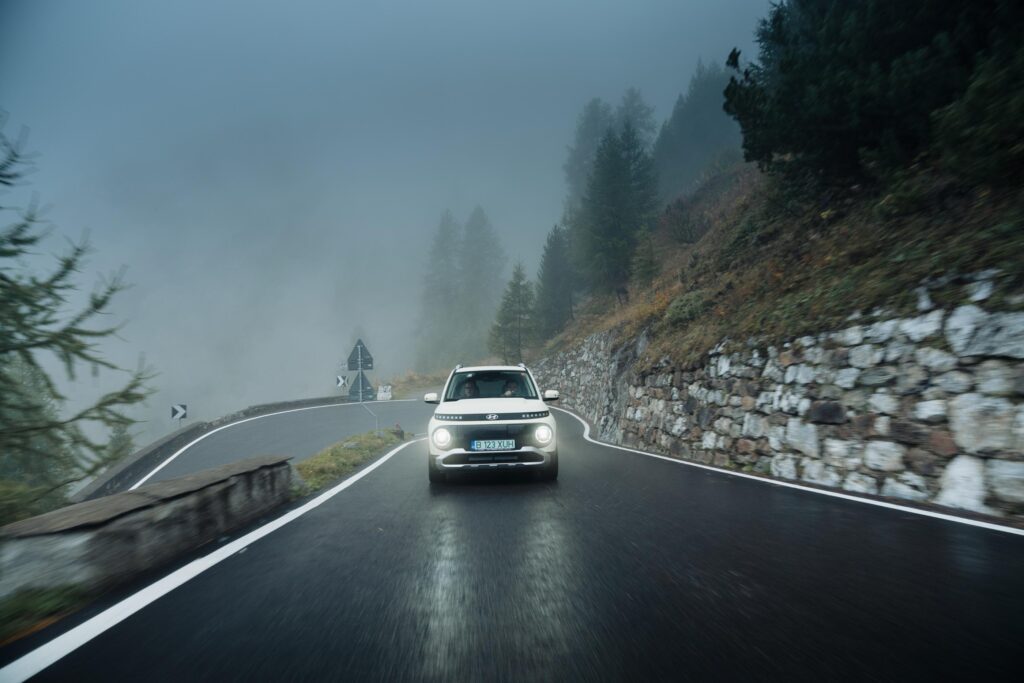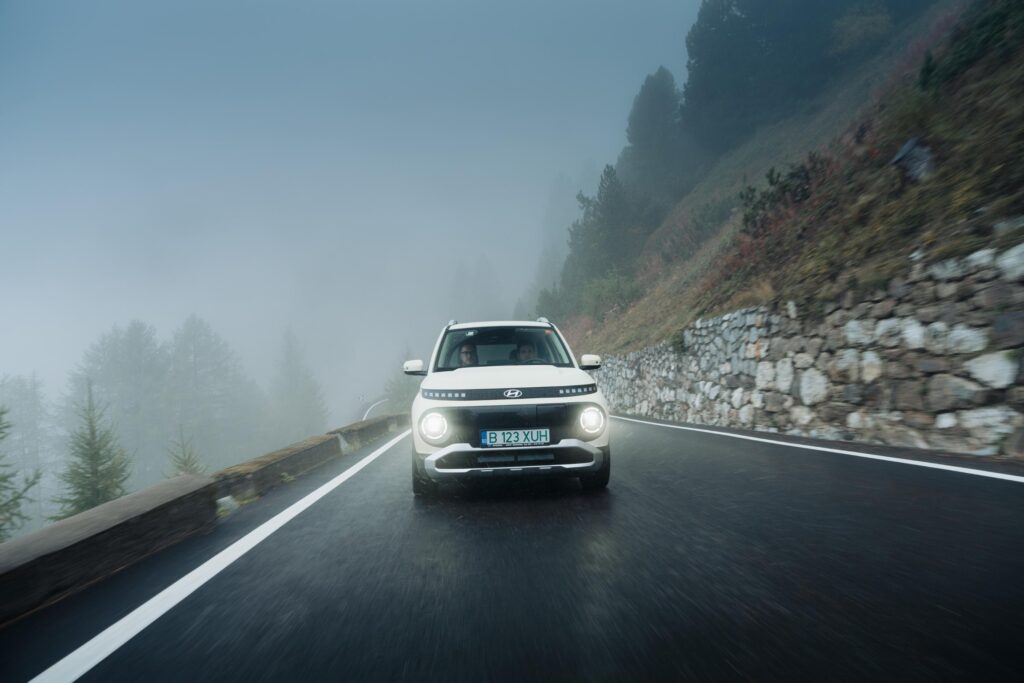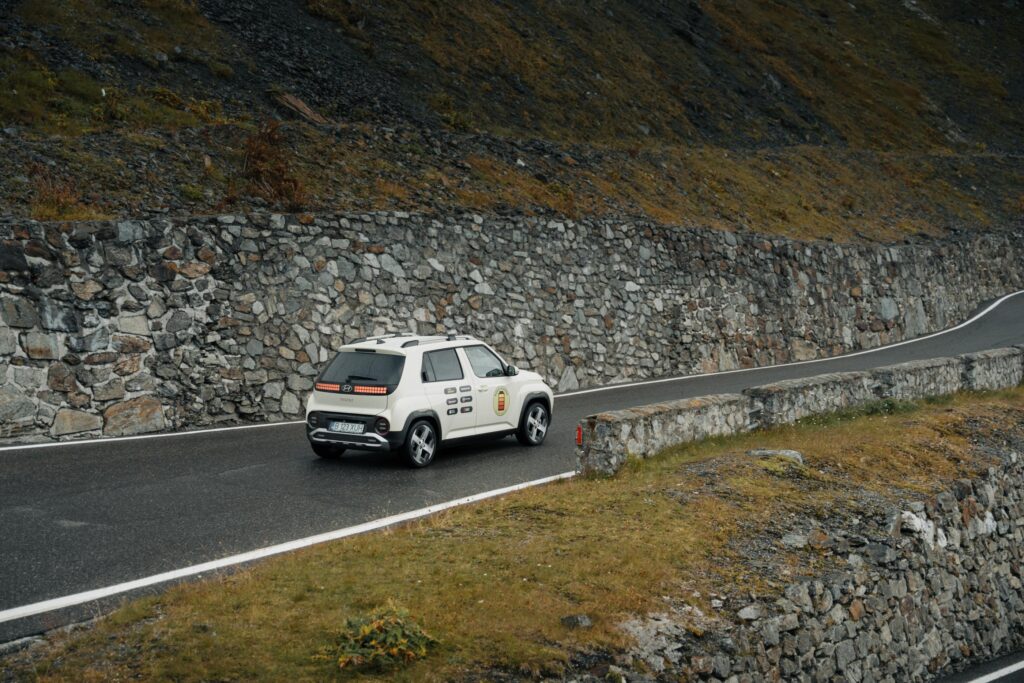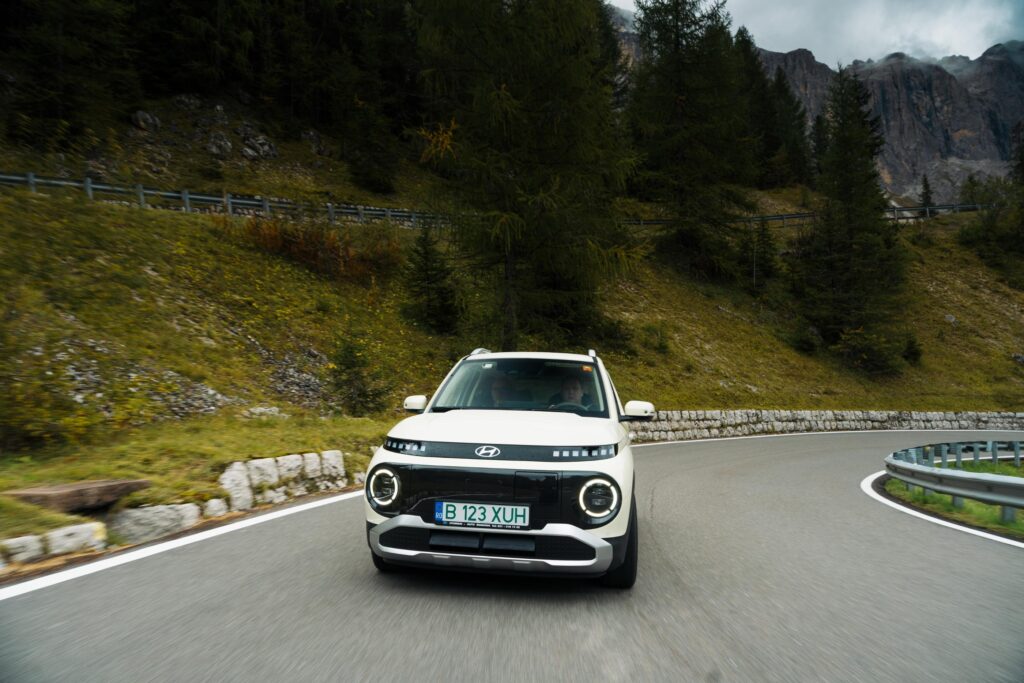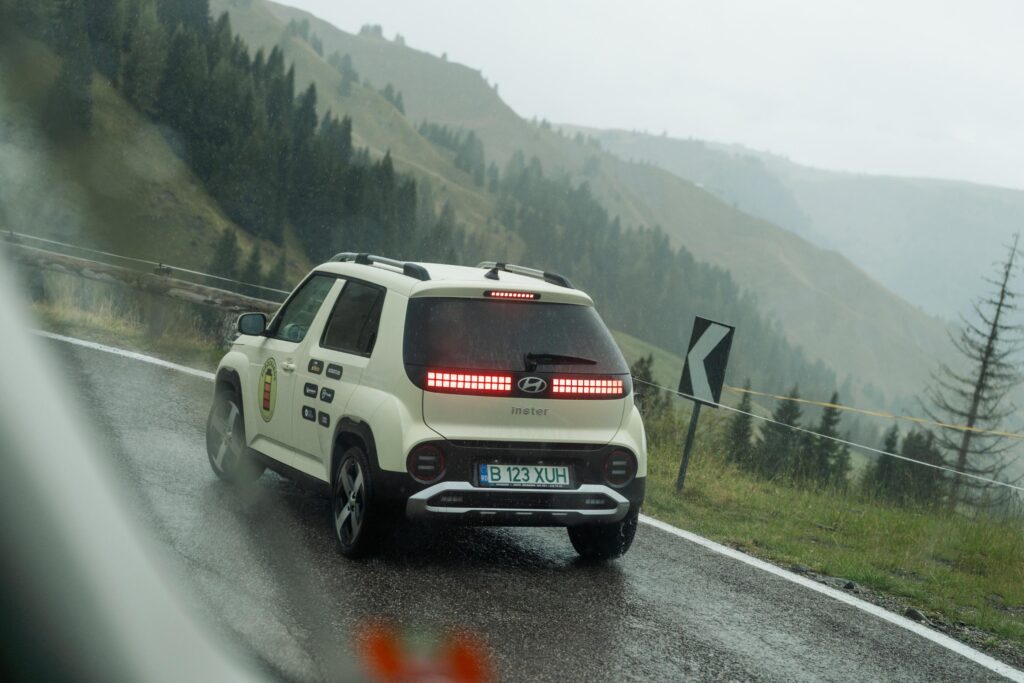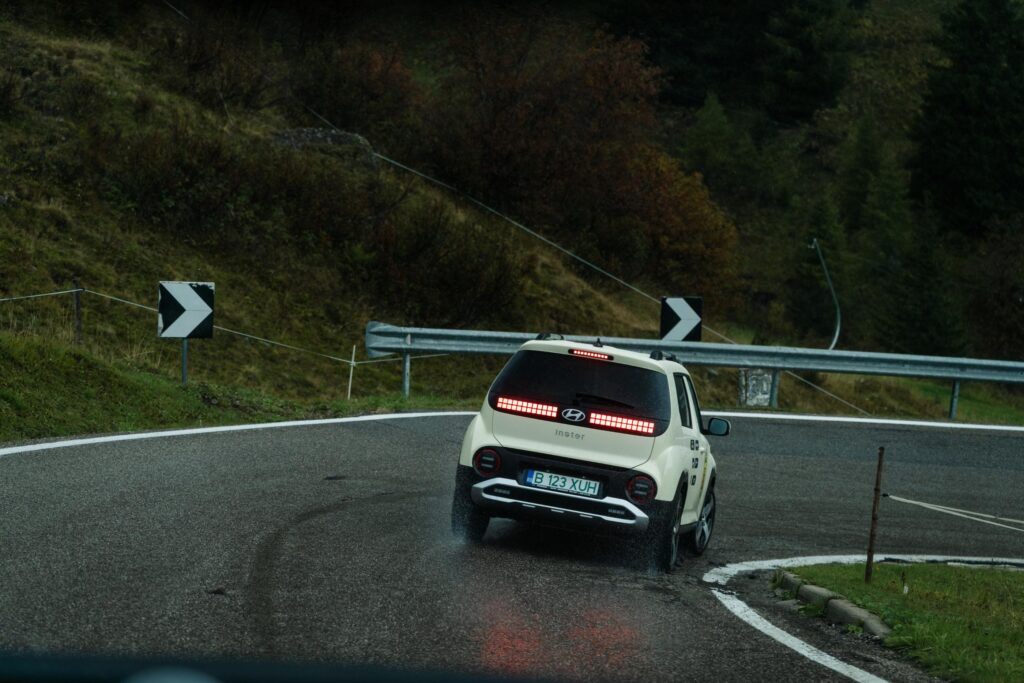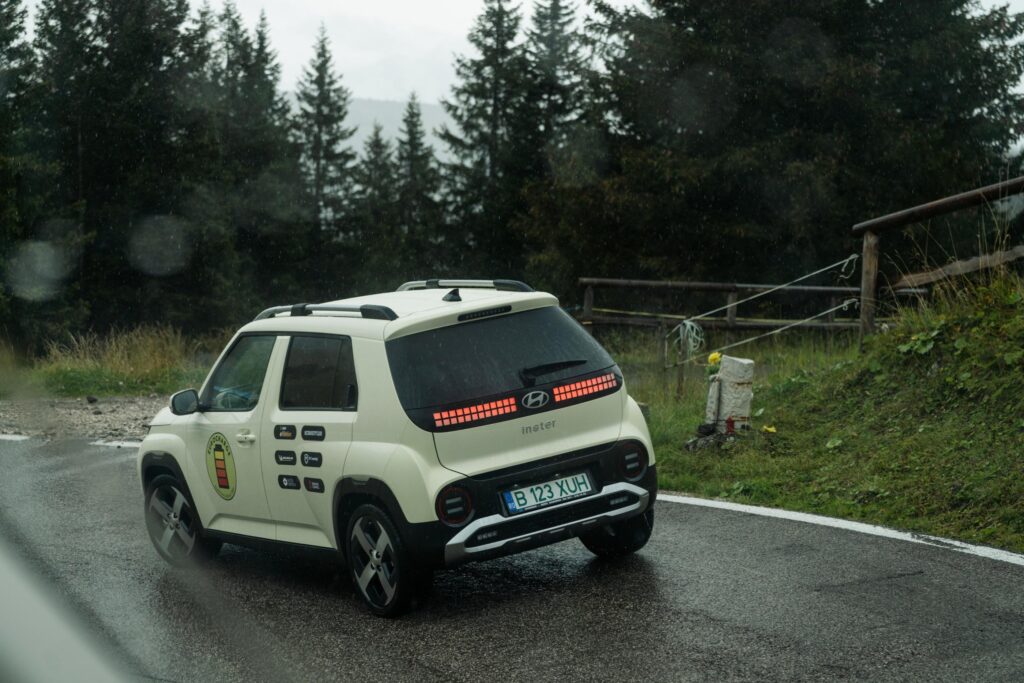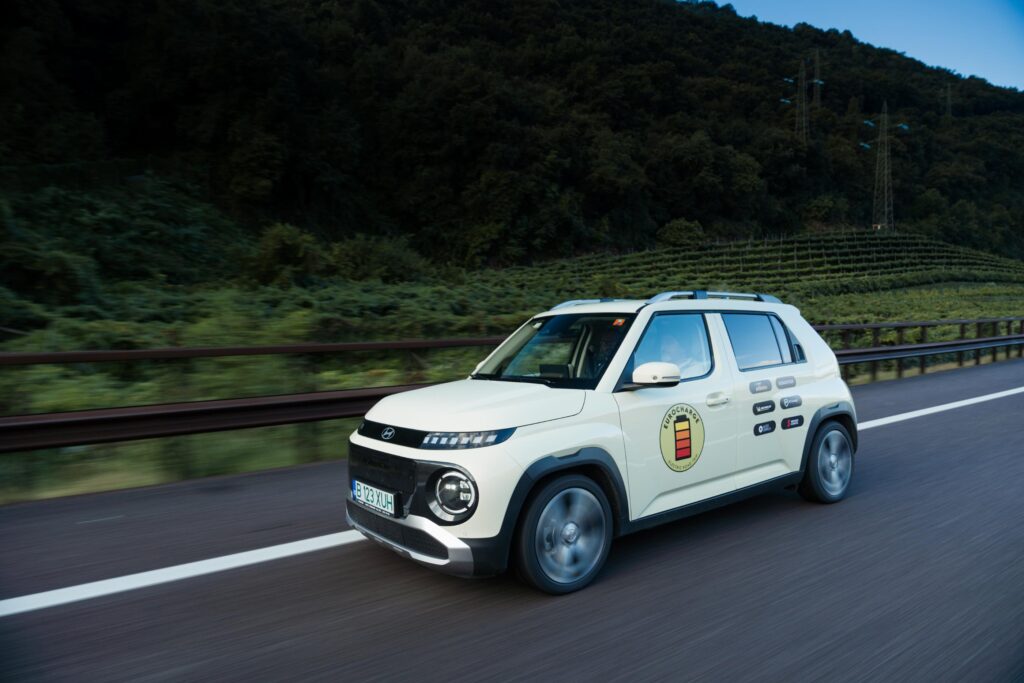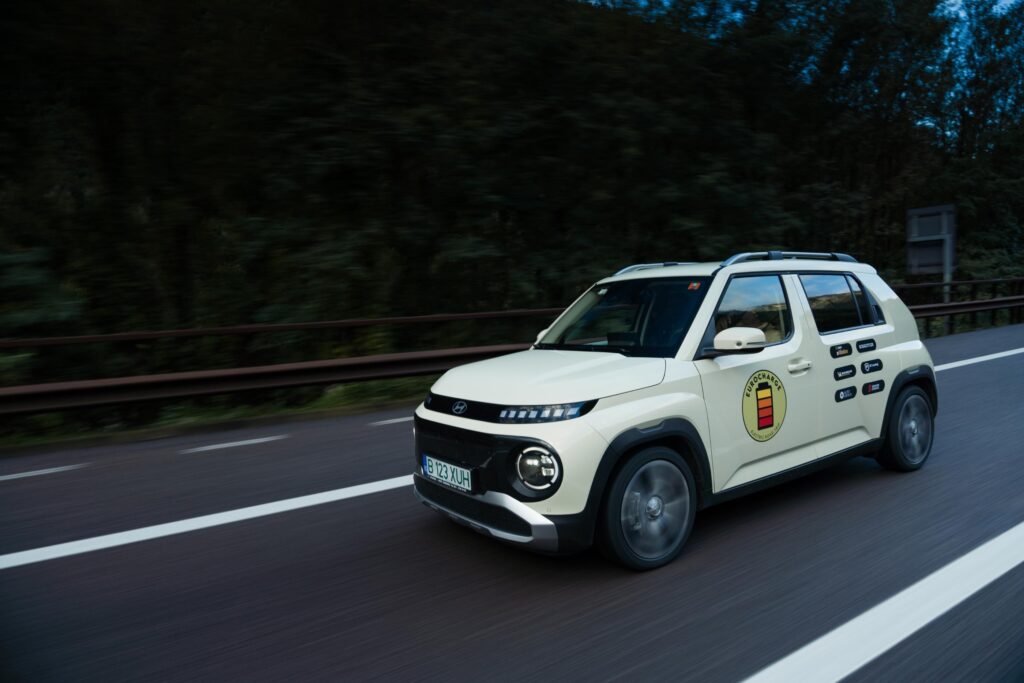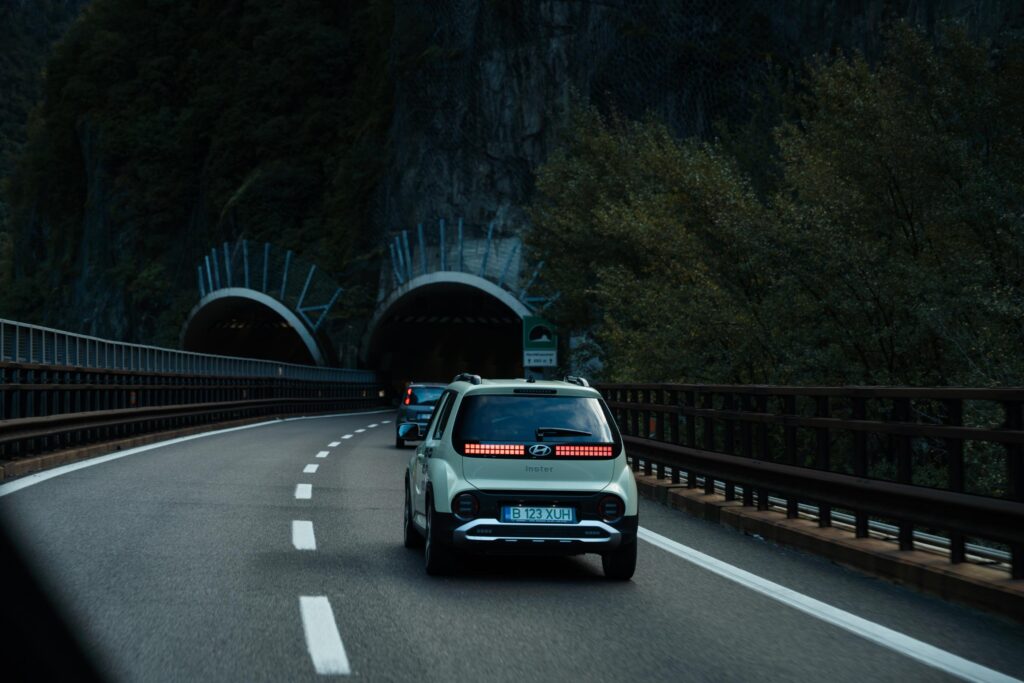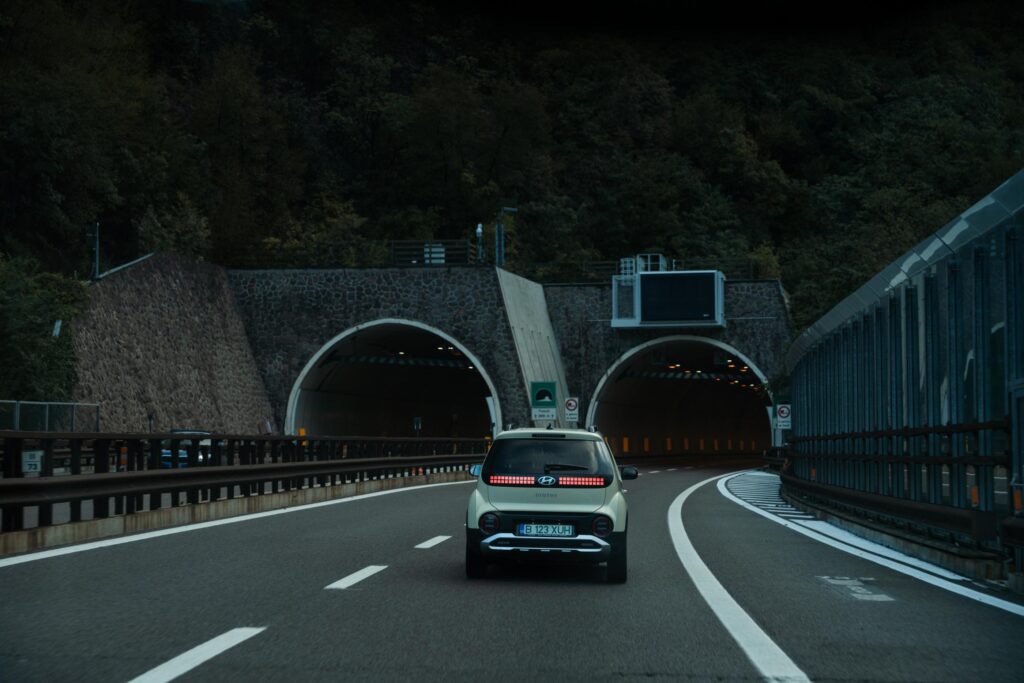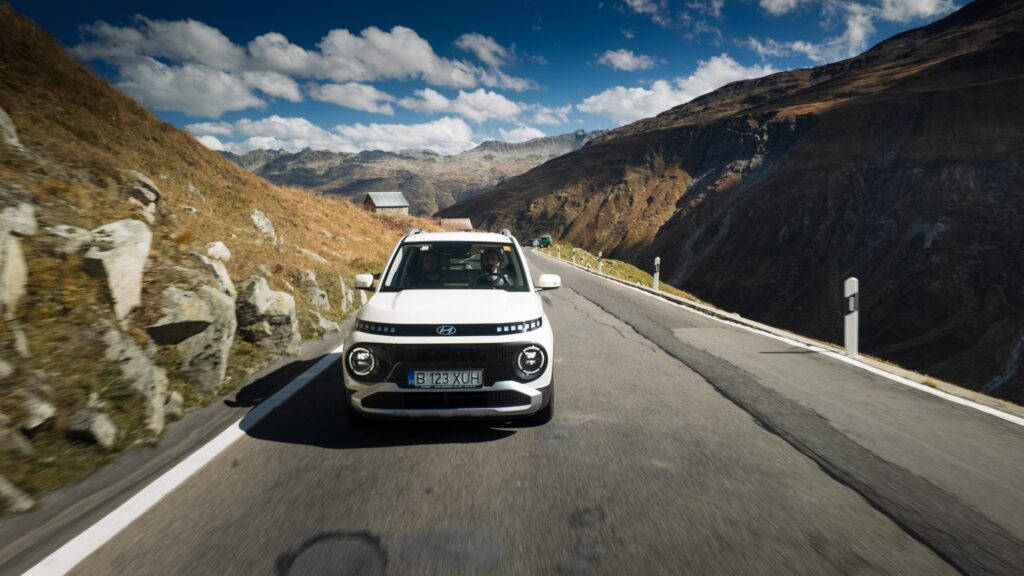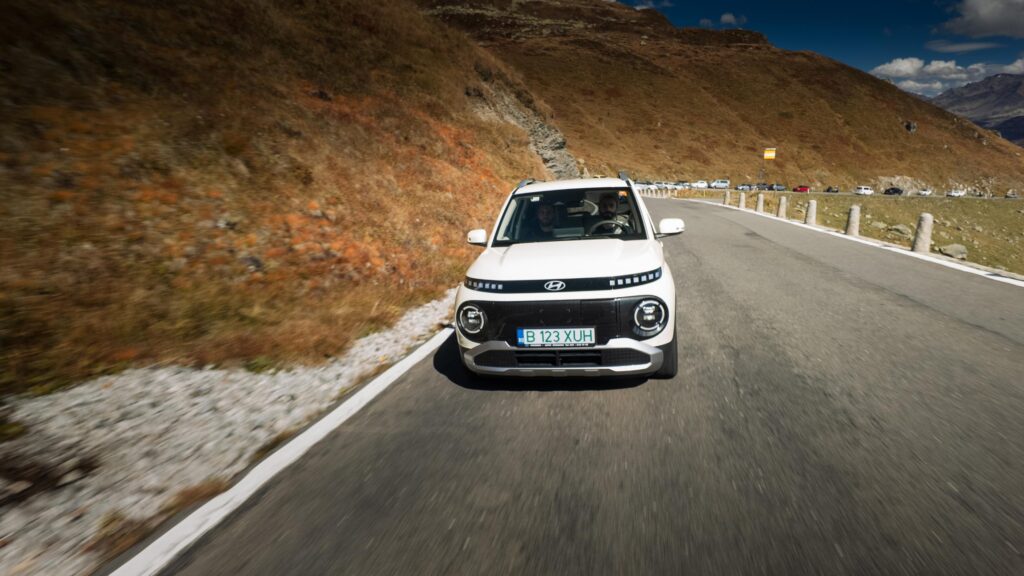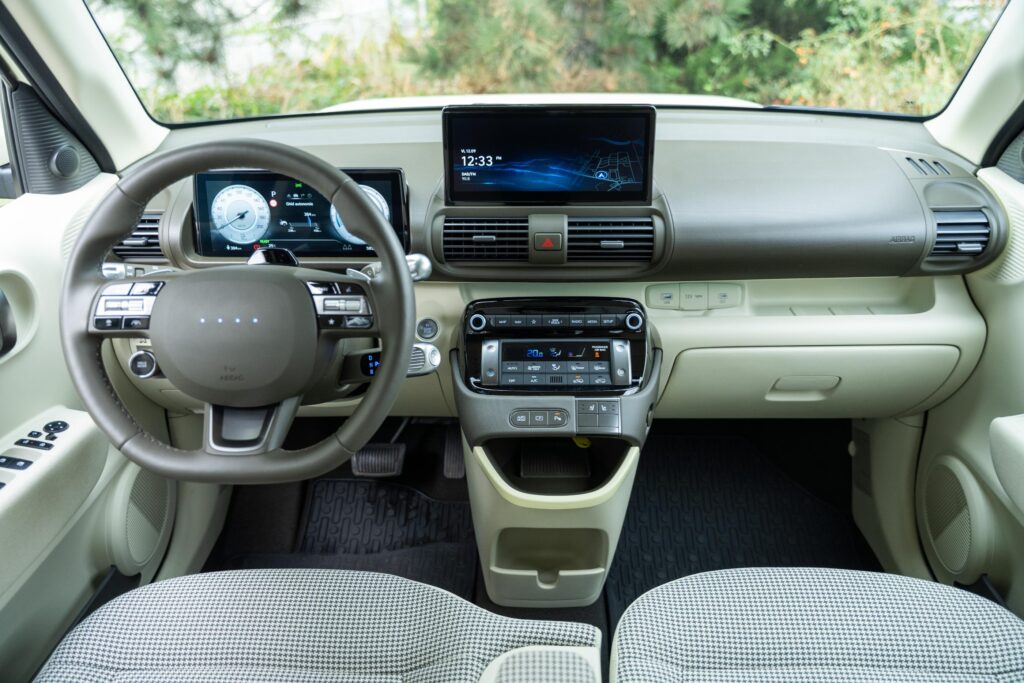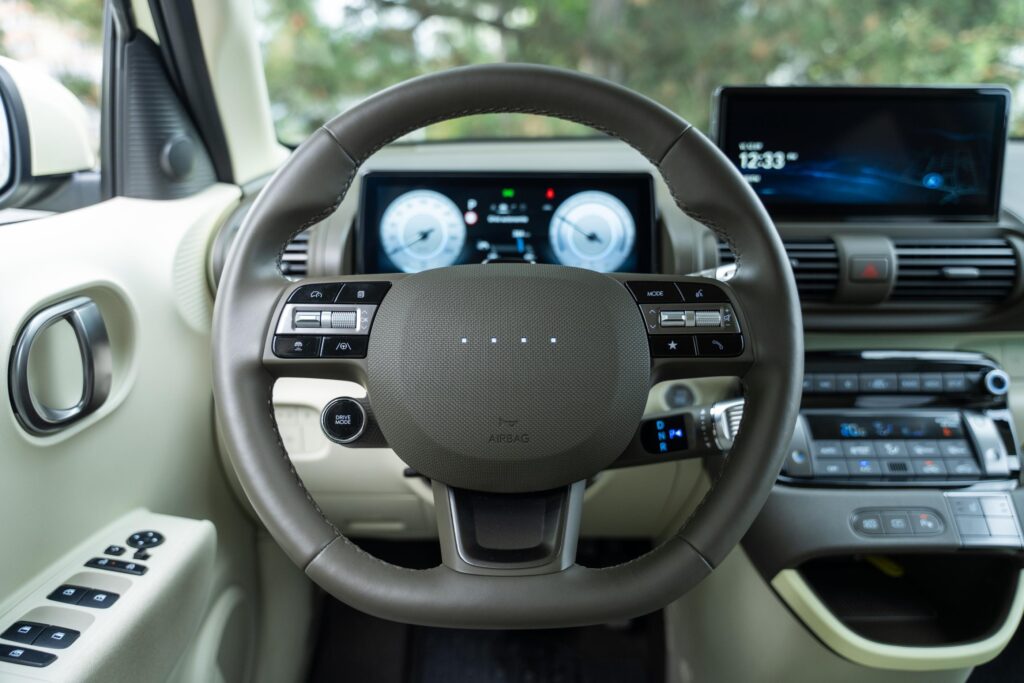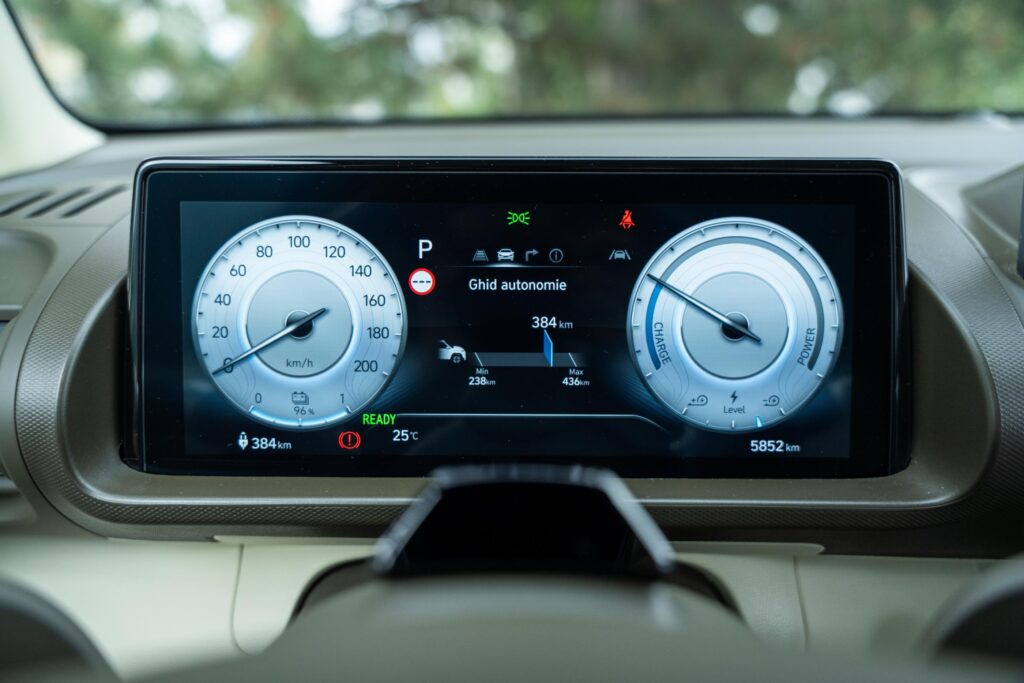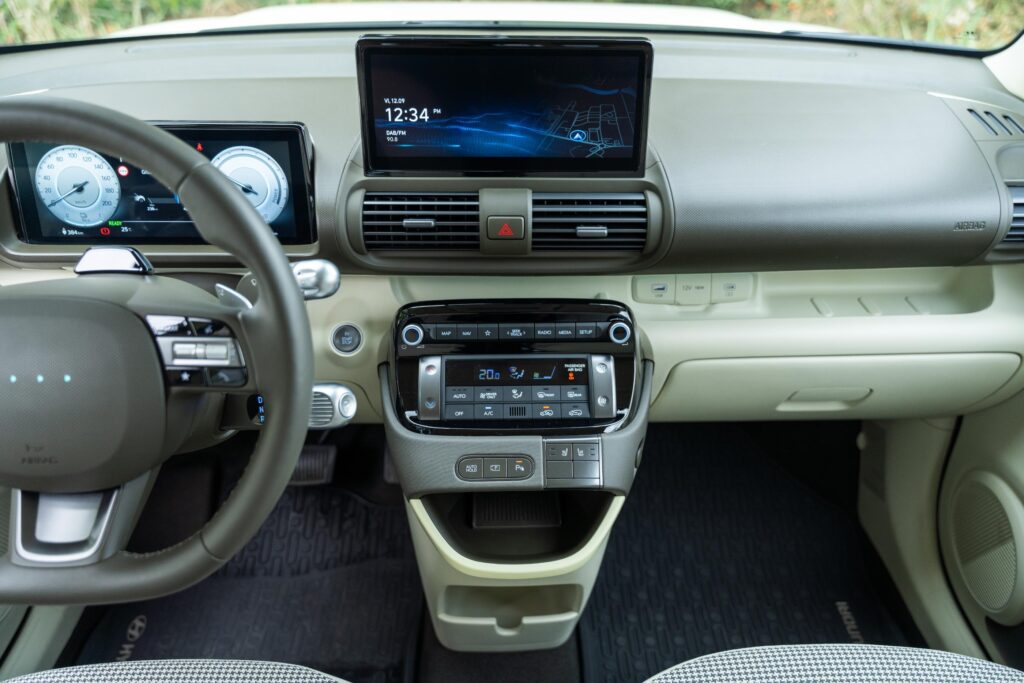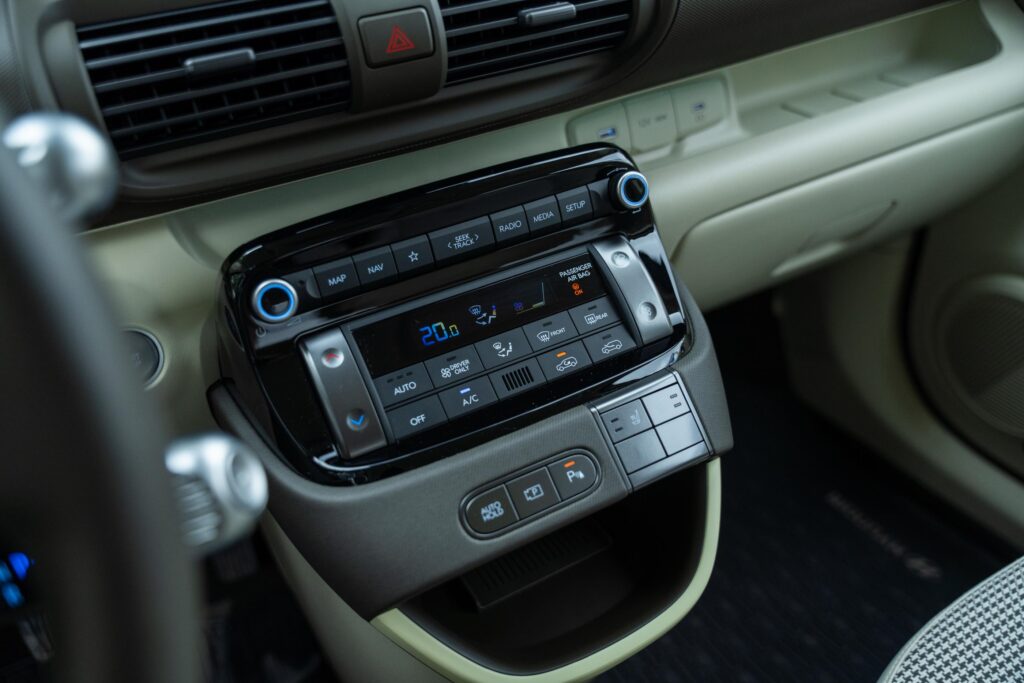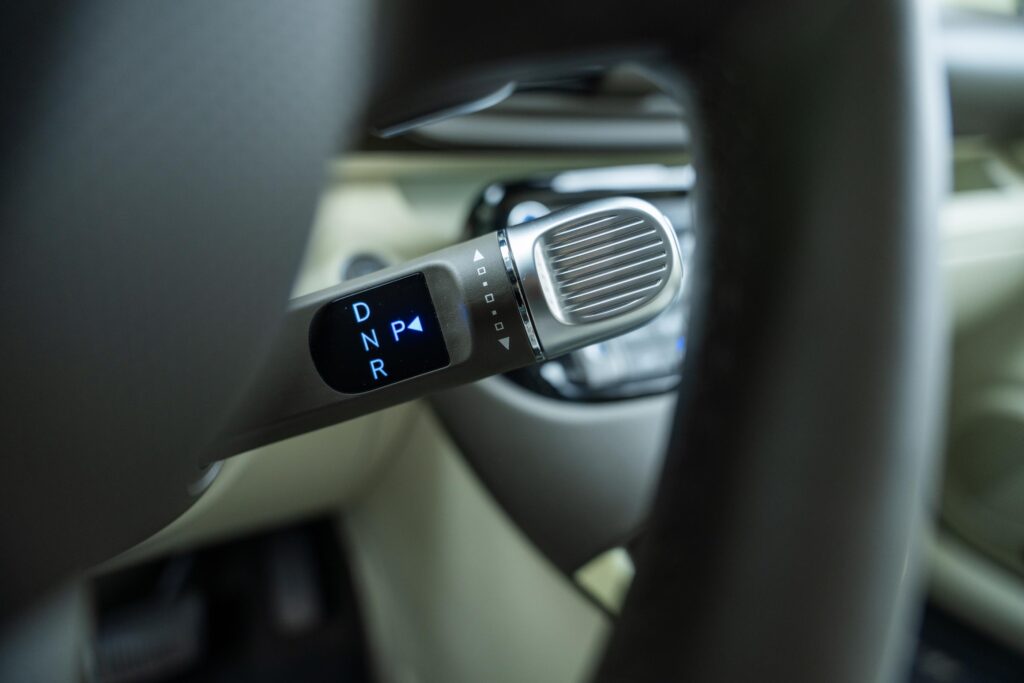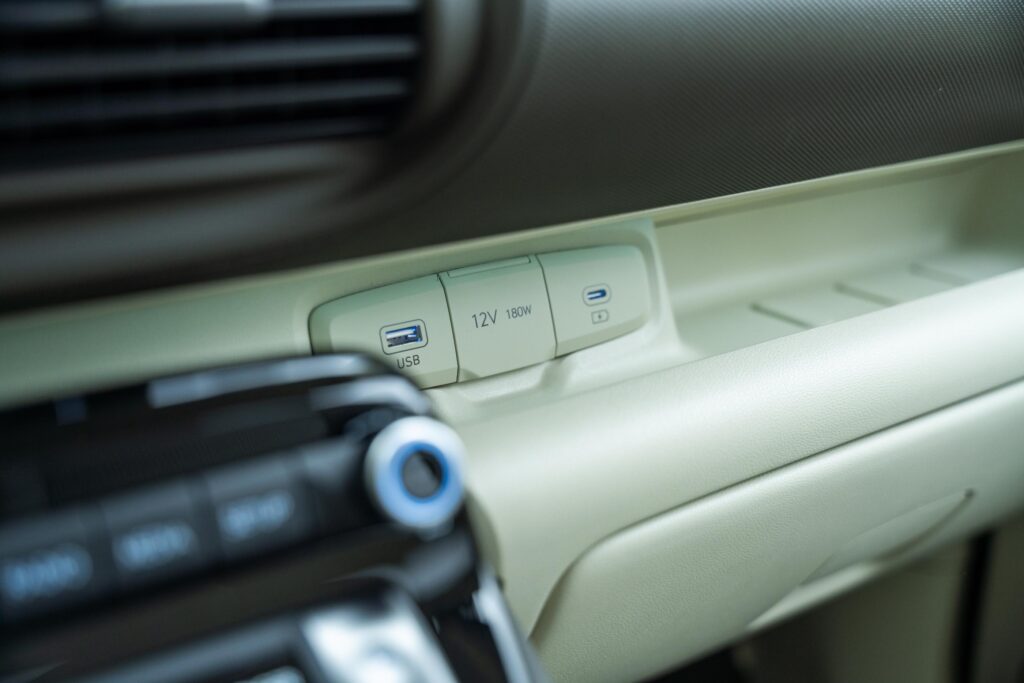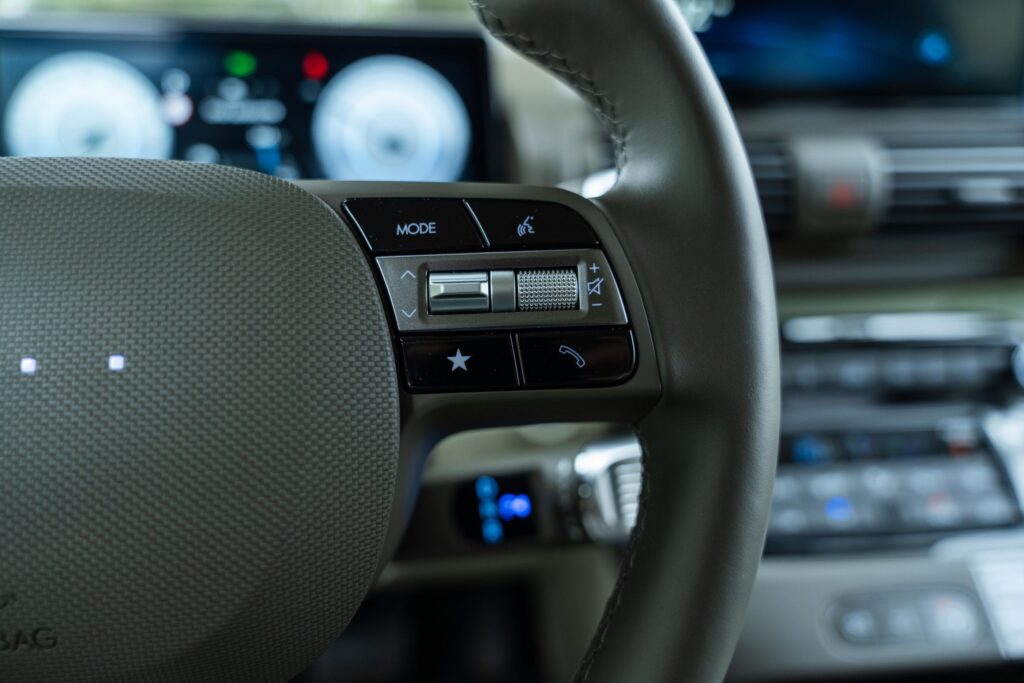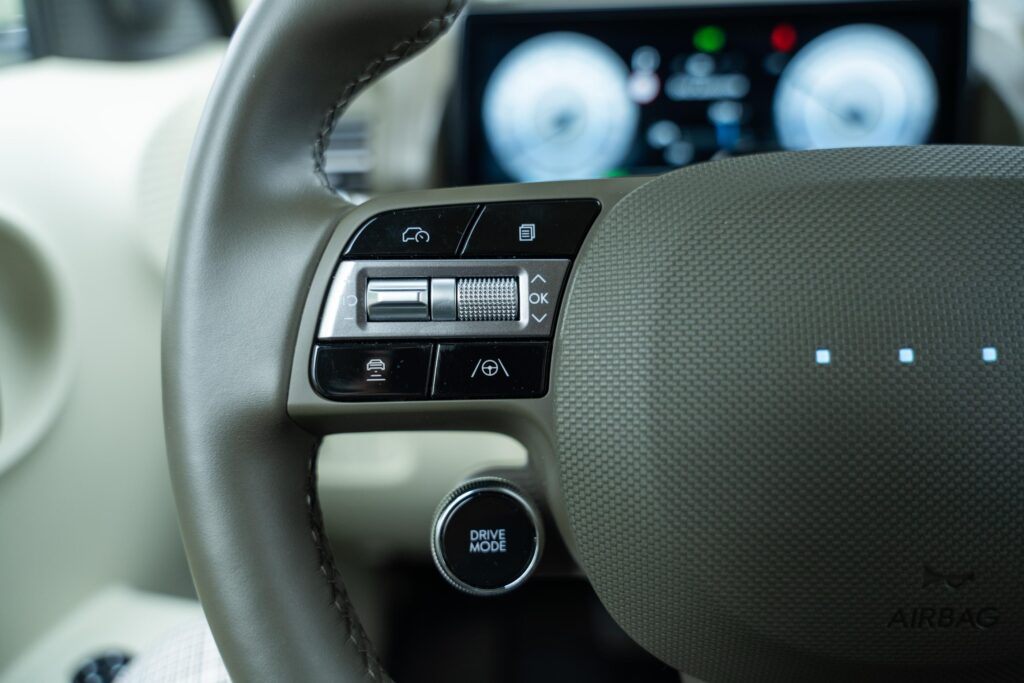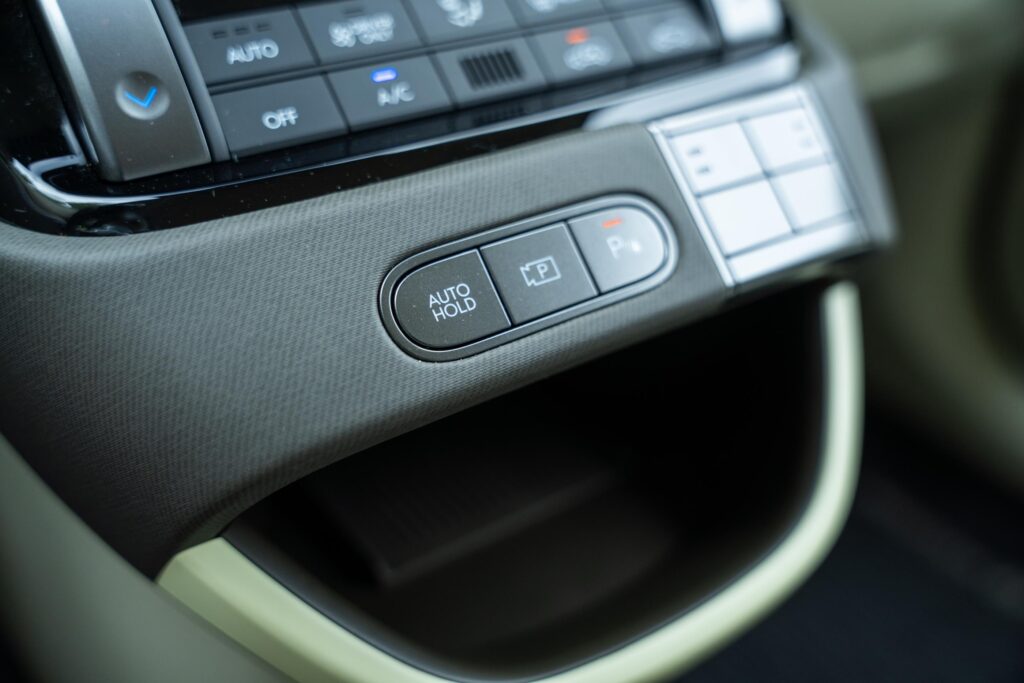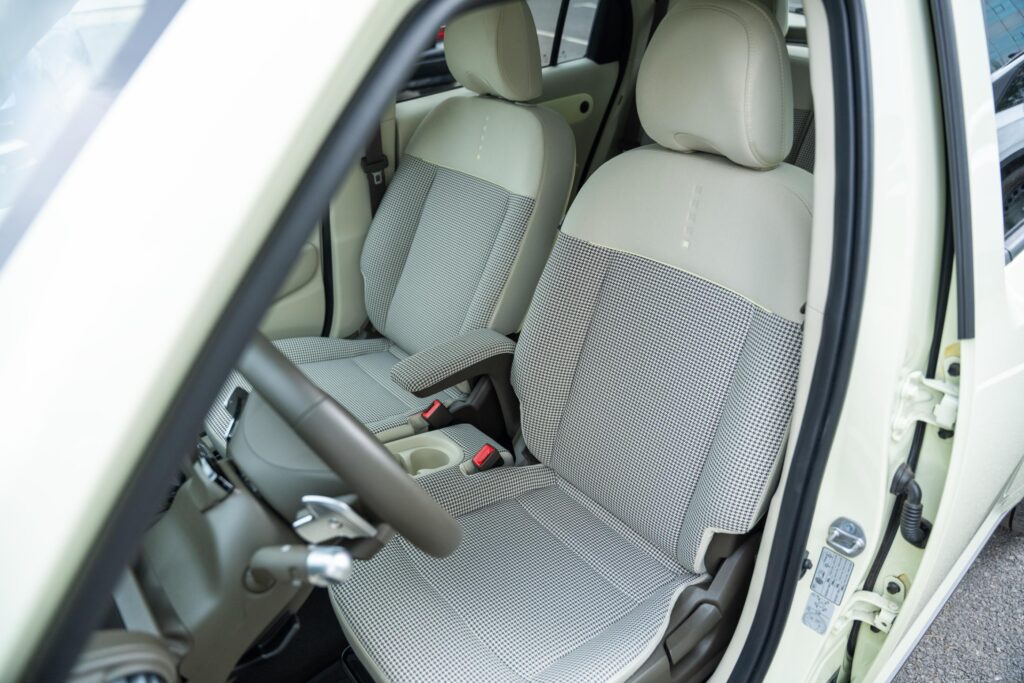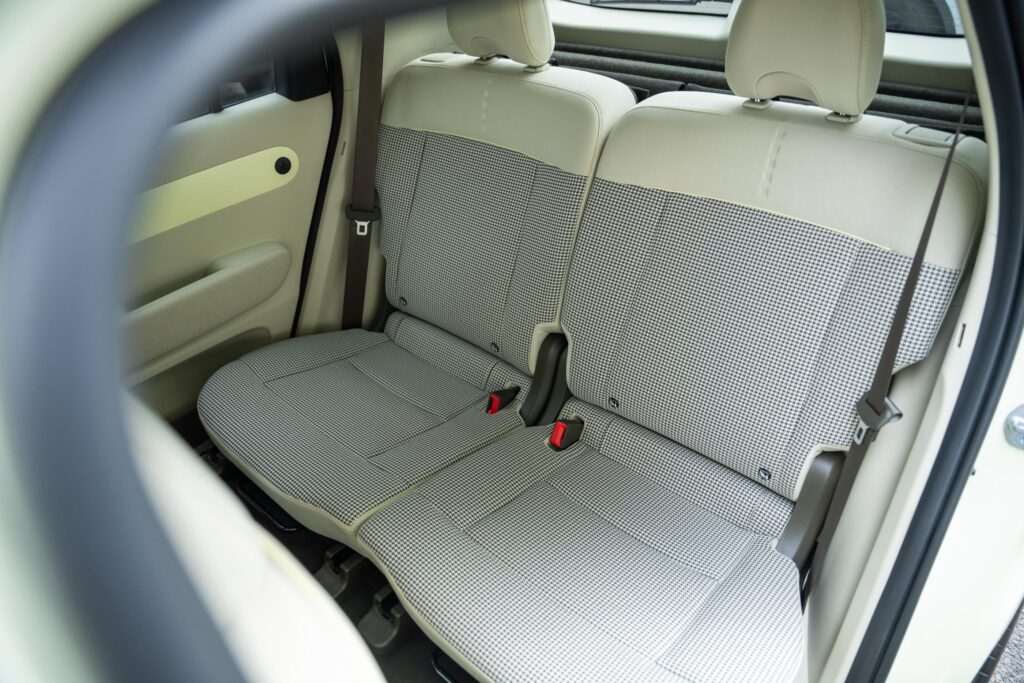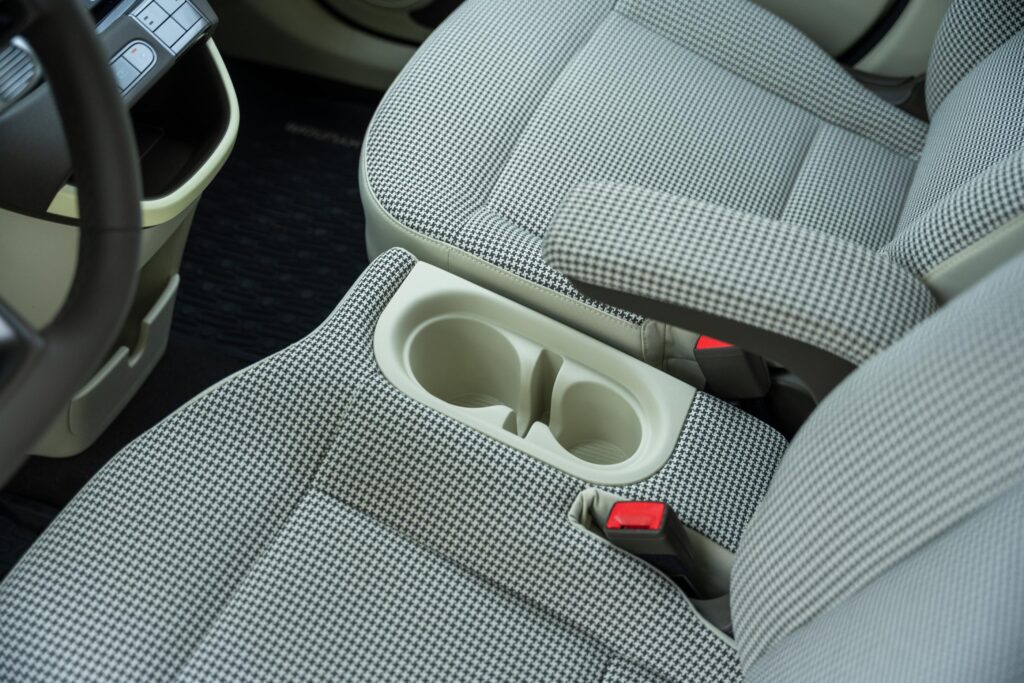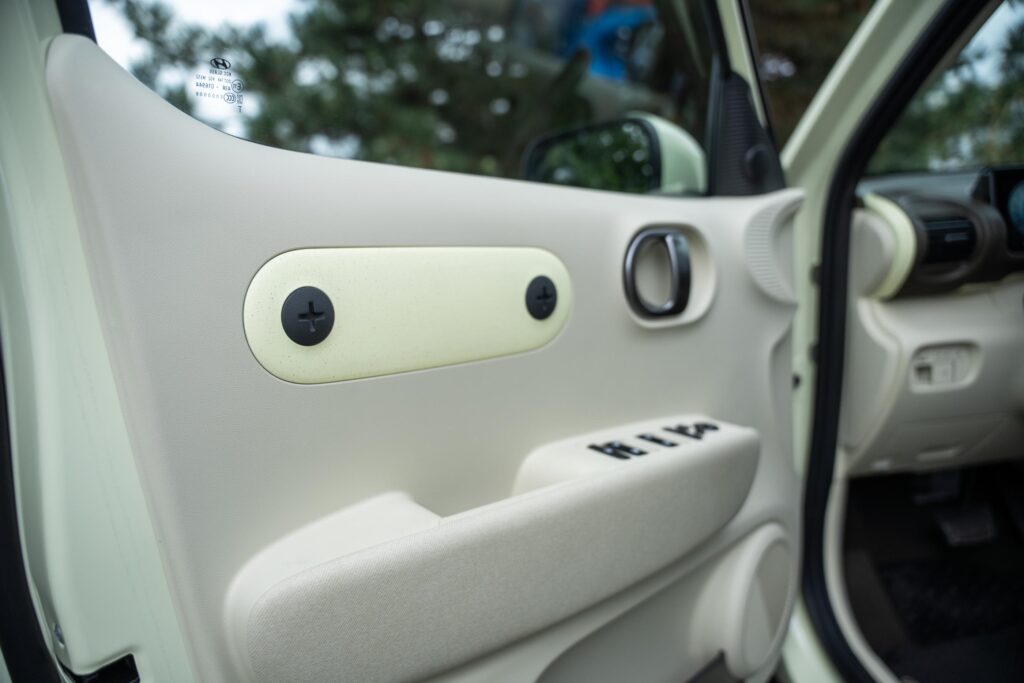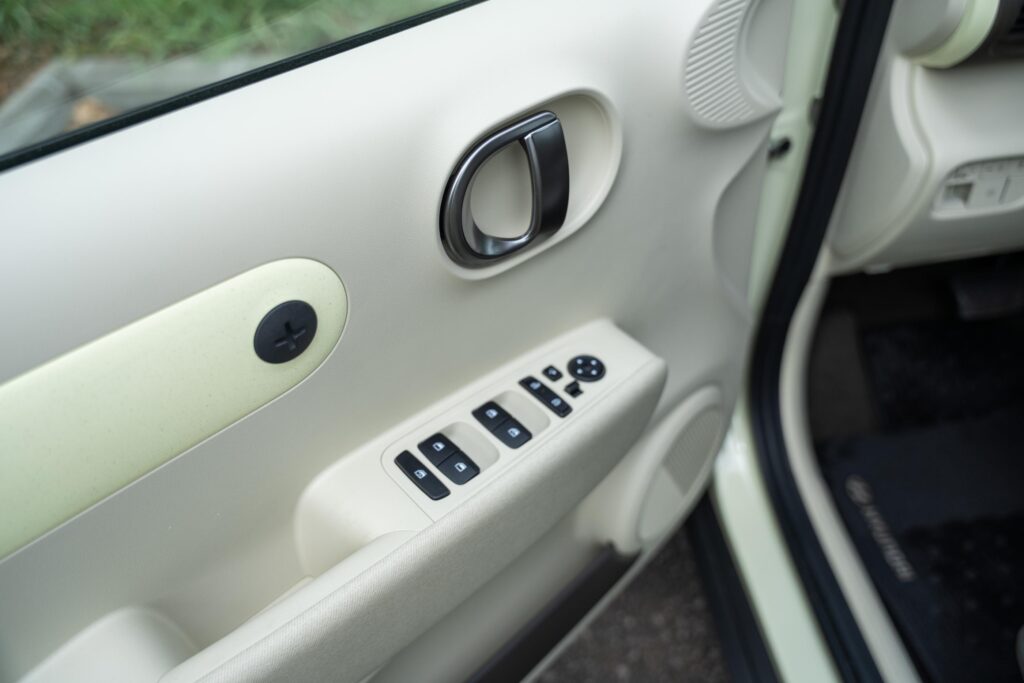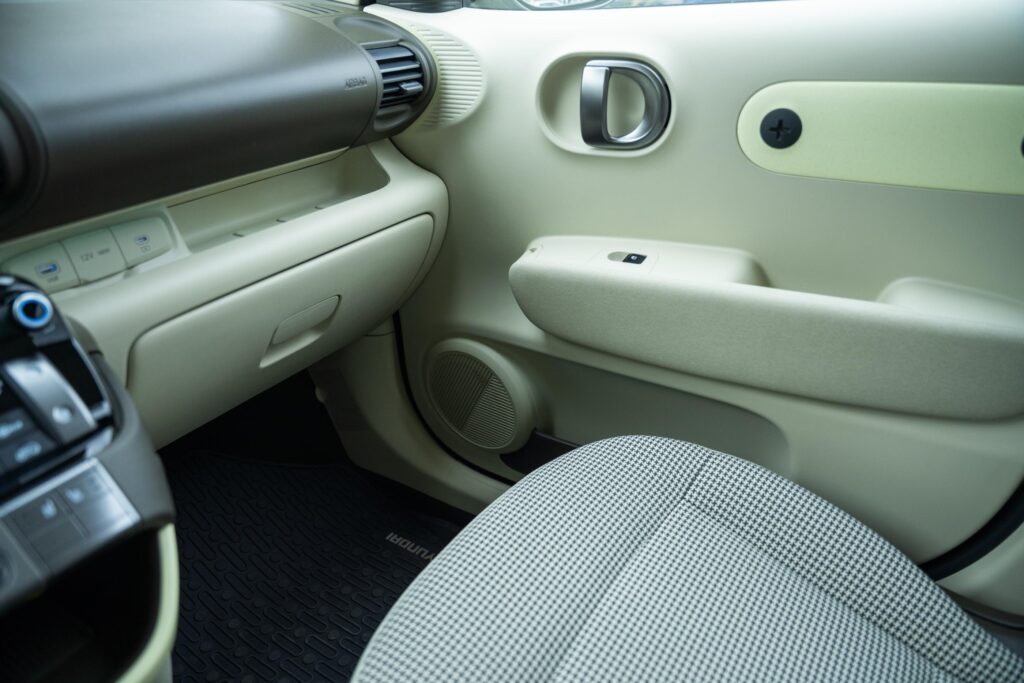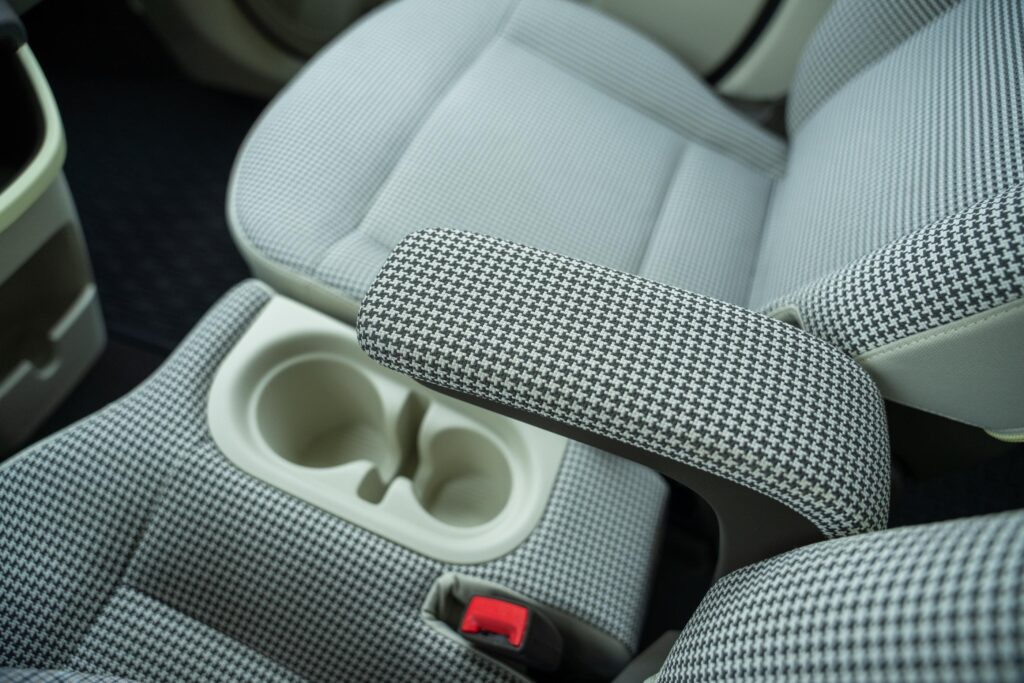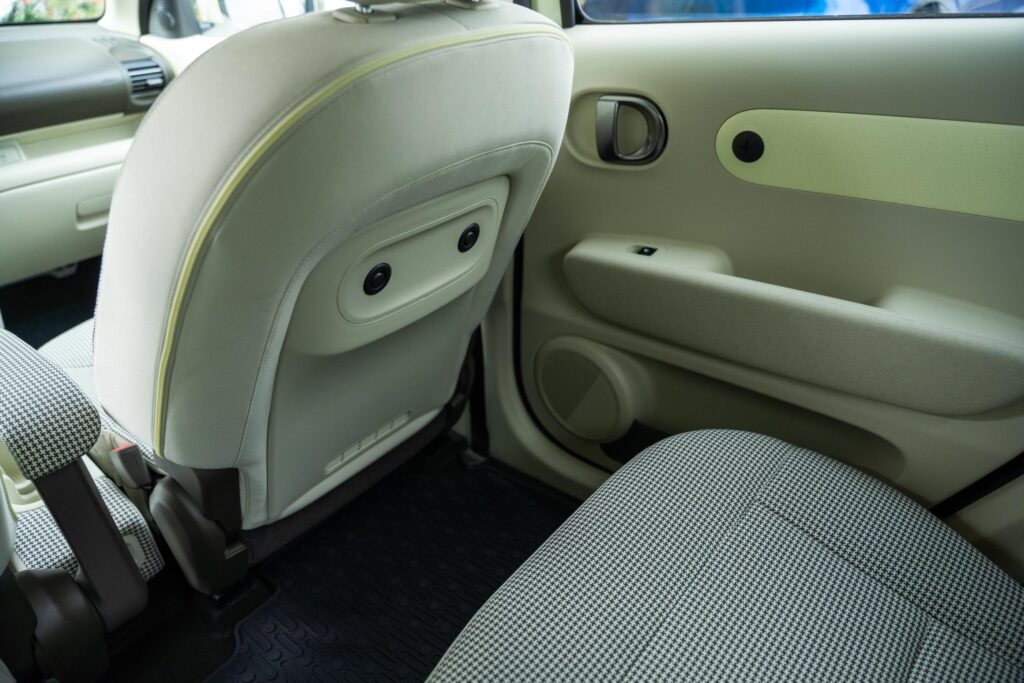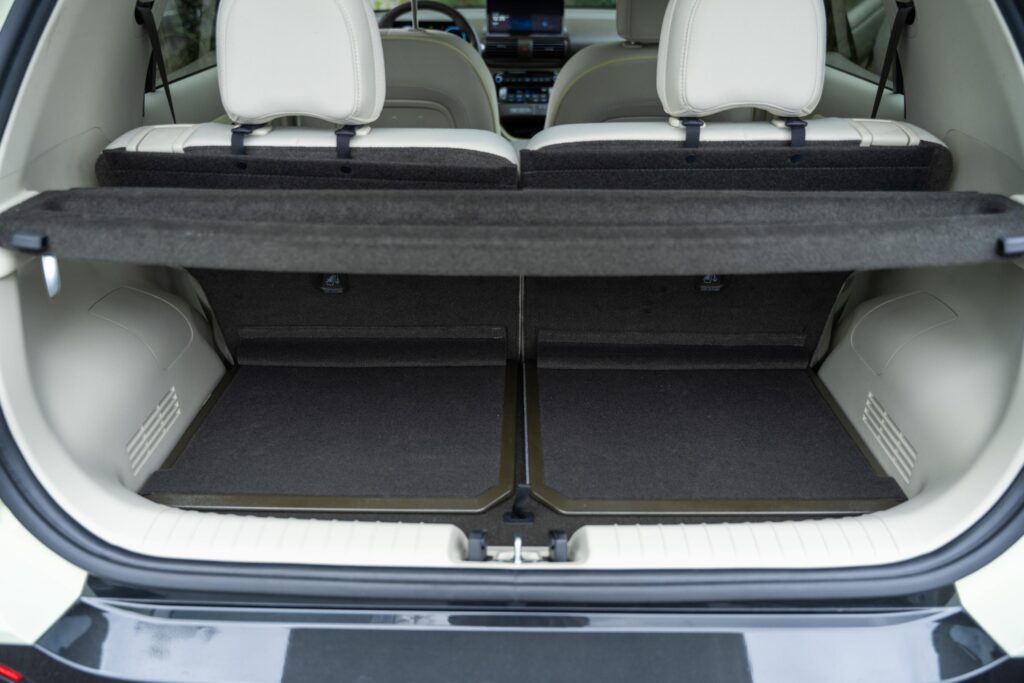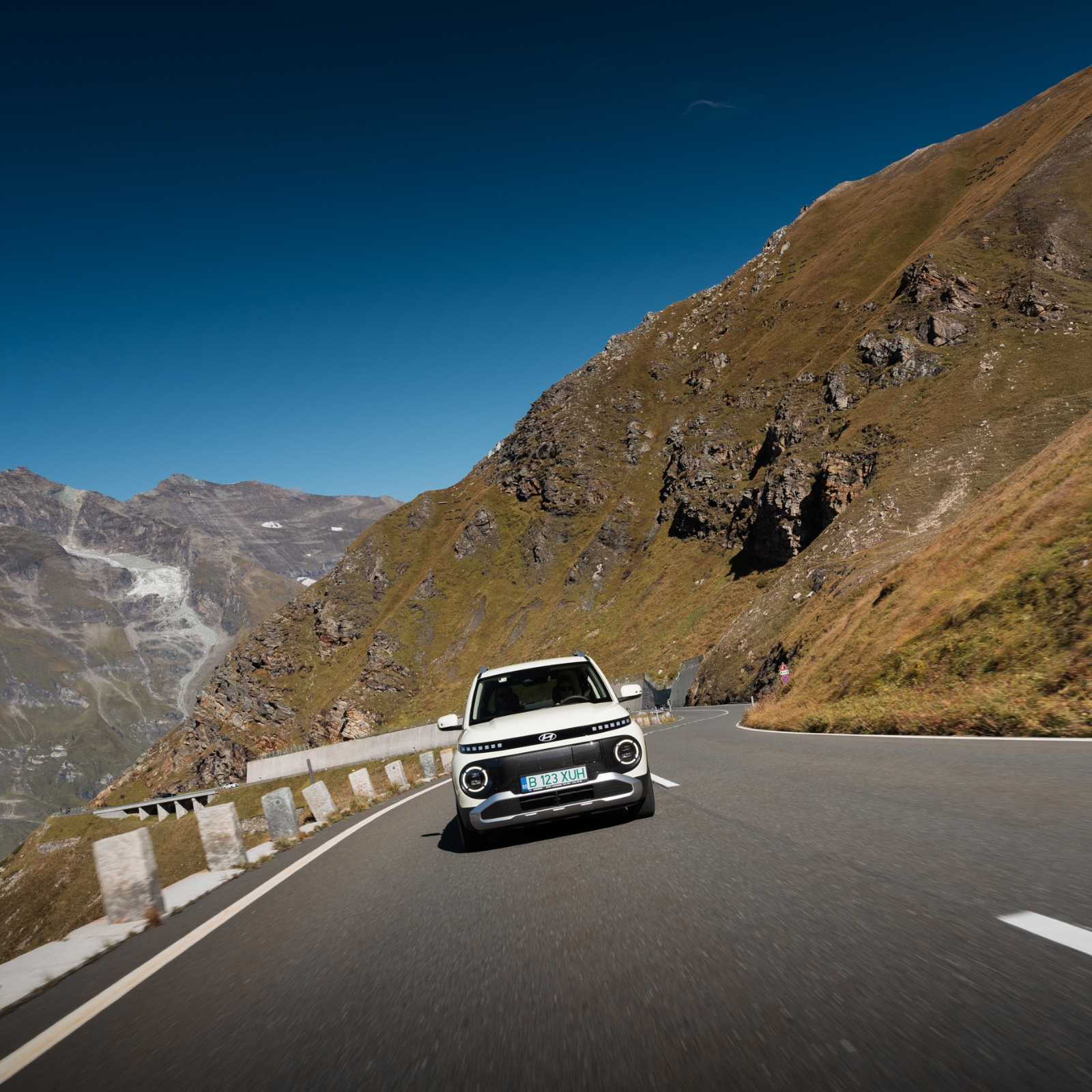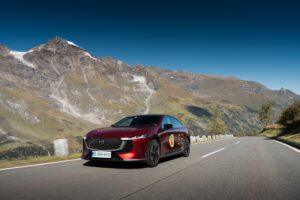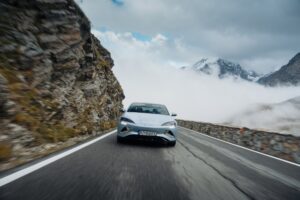Hyundai is one of those manufacturers that know their EVs. The Ioniq family, with its 800V platform, has shown that electric cars can tick several boxes: fast charging, range and efficiency. Smaller market segments have been tackled with the Kona and, more recently, the Inster, the junior of this project.
The Inster has covered almost 5,000 kilometers from Romania to the Alpine passes of Austria, Switzerland and Italy. One of its strengths? Low energy consumption, which you’ll see in the infographic below. It also scored a few points when it came to dynamic character (the model’s small mass scored well here too) and also made the most of its tiny dimensions when the road got really narrow on some of the mountain passes we crossed.
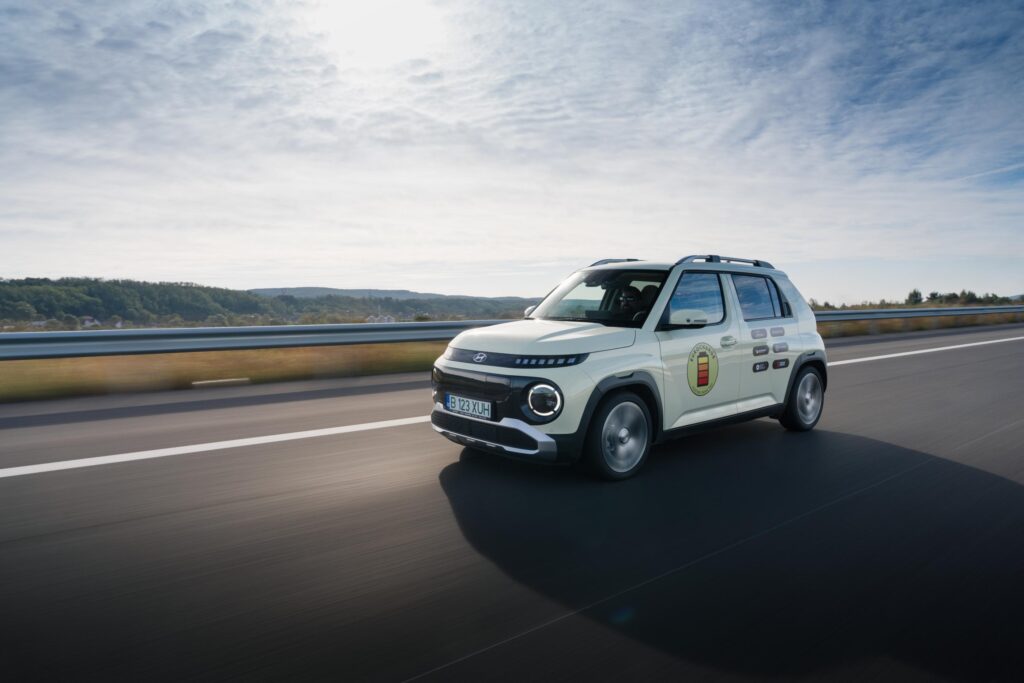
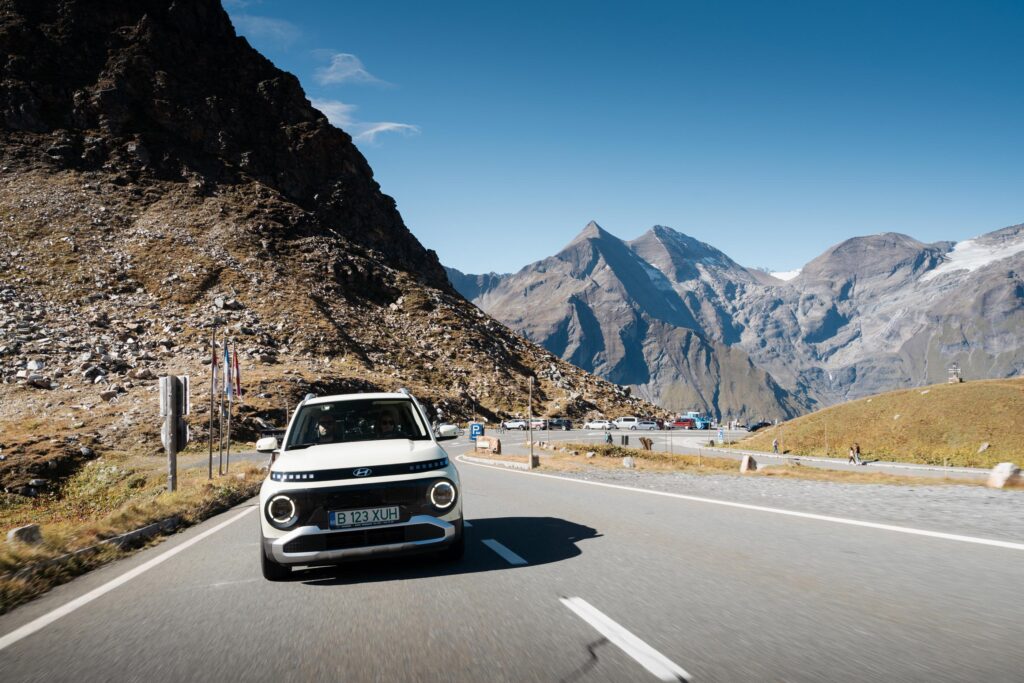
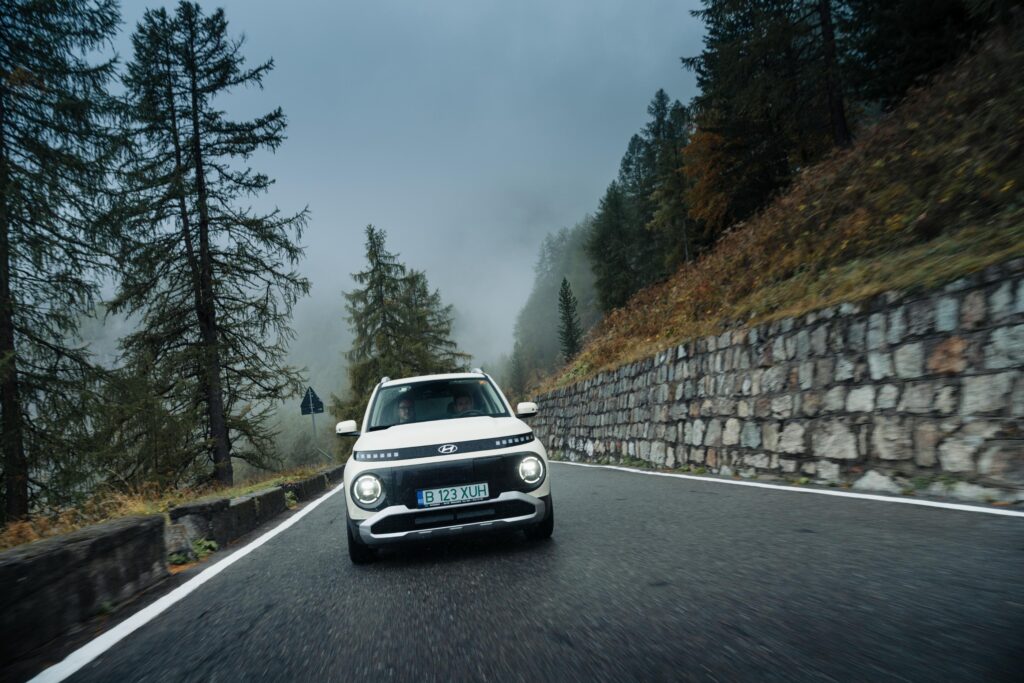
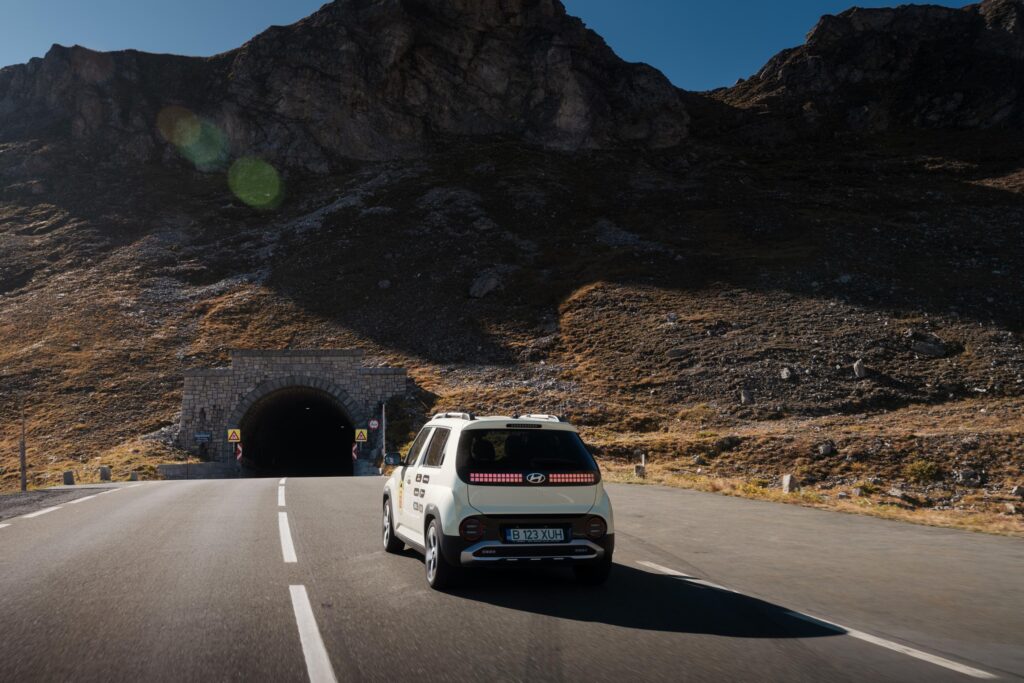
Hyundai Inster: daily infographics on consumption, real range, charging costs
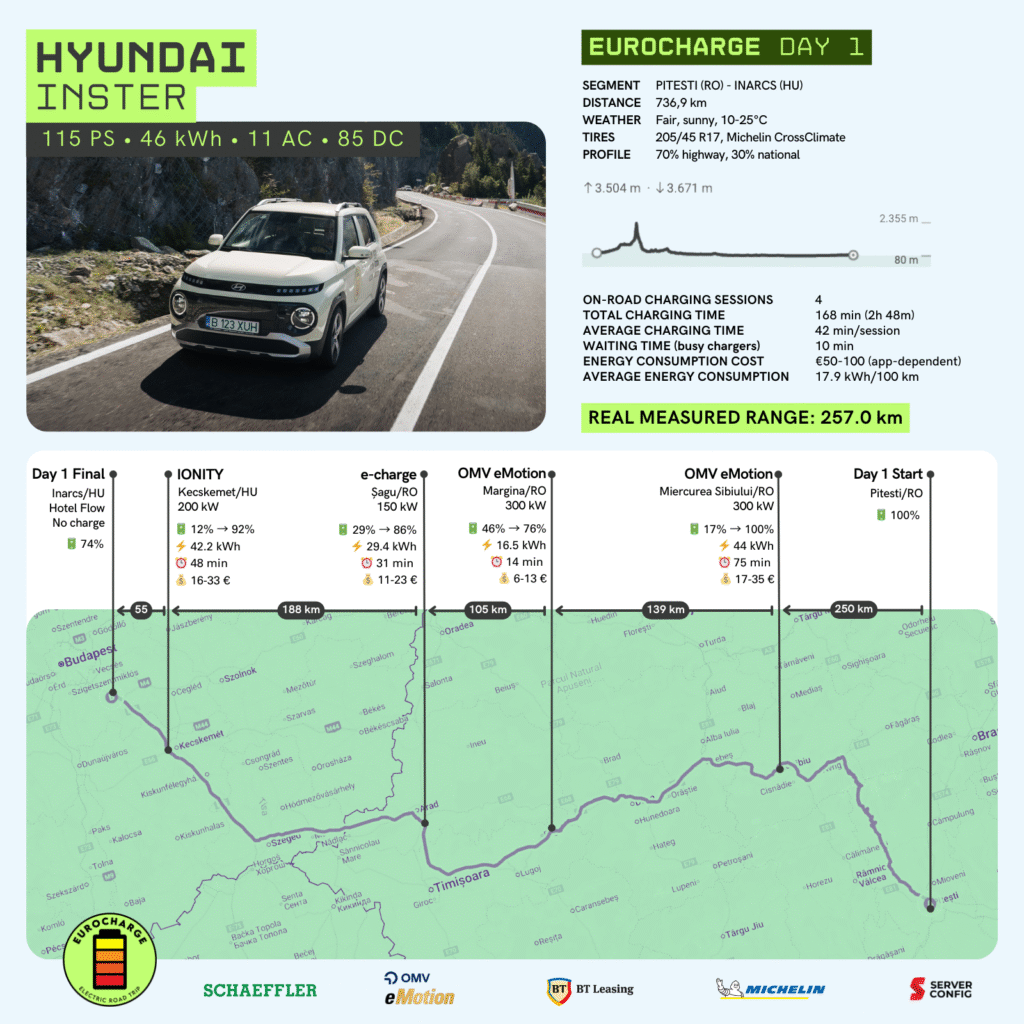
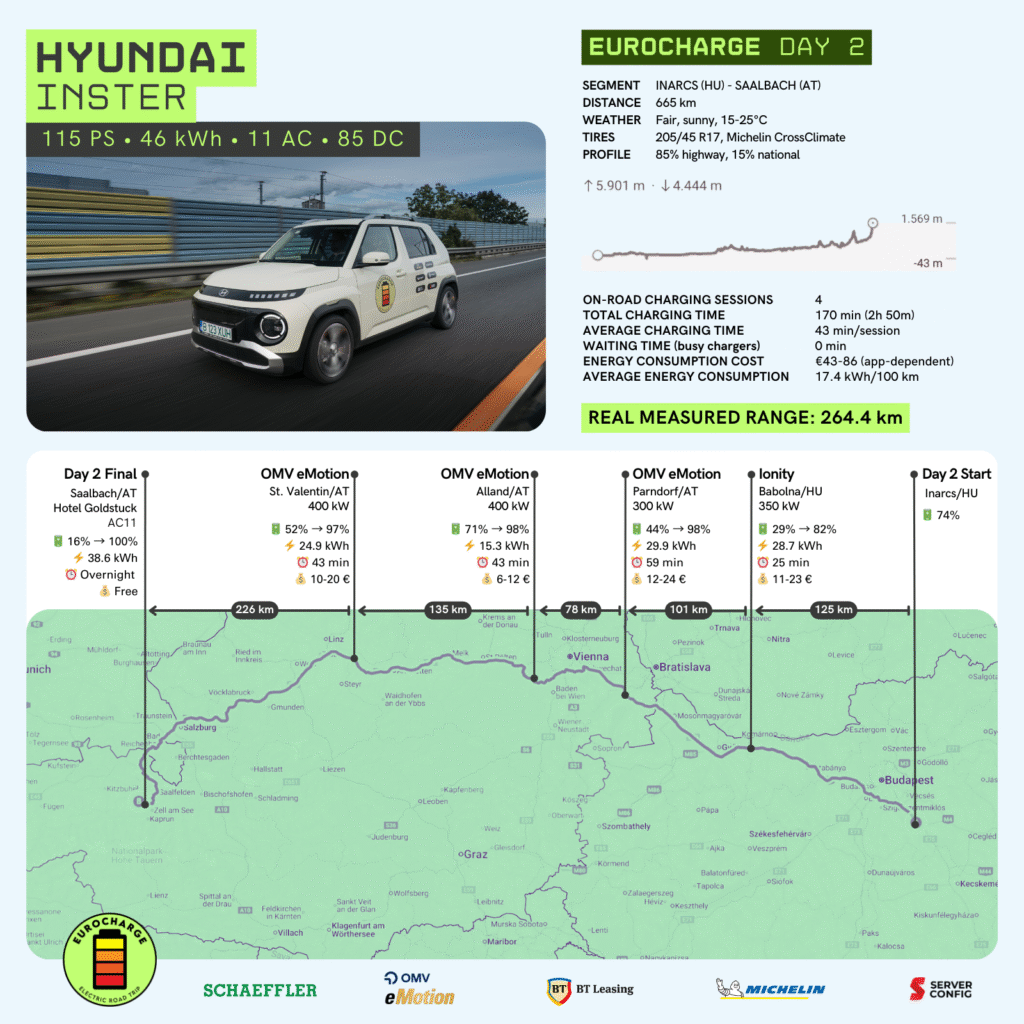
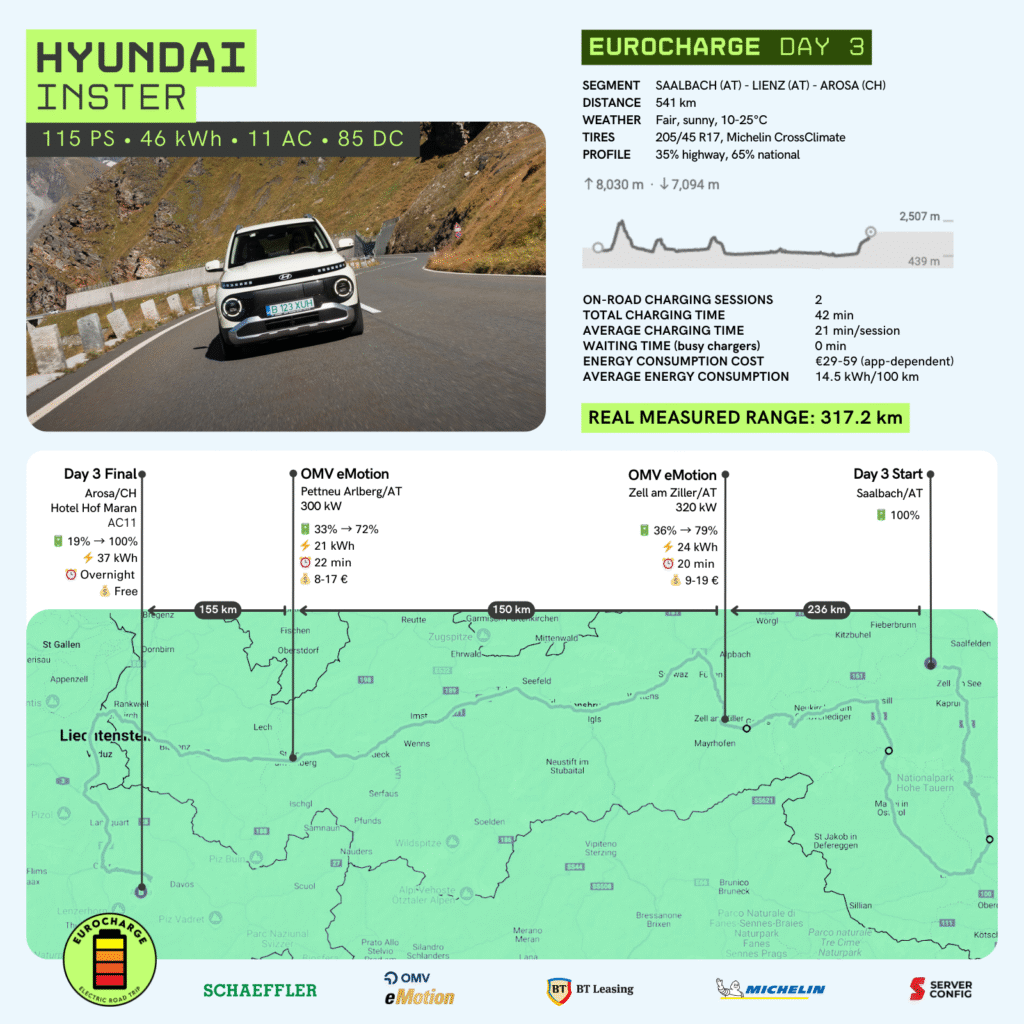
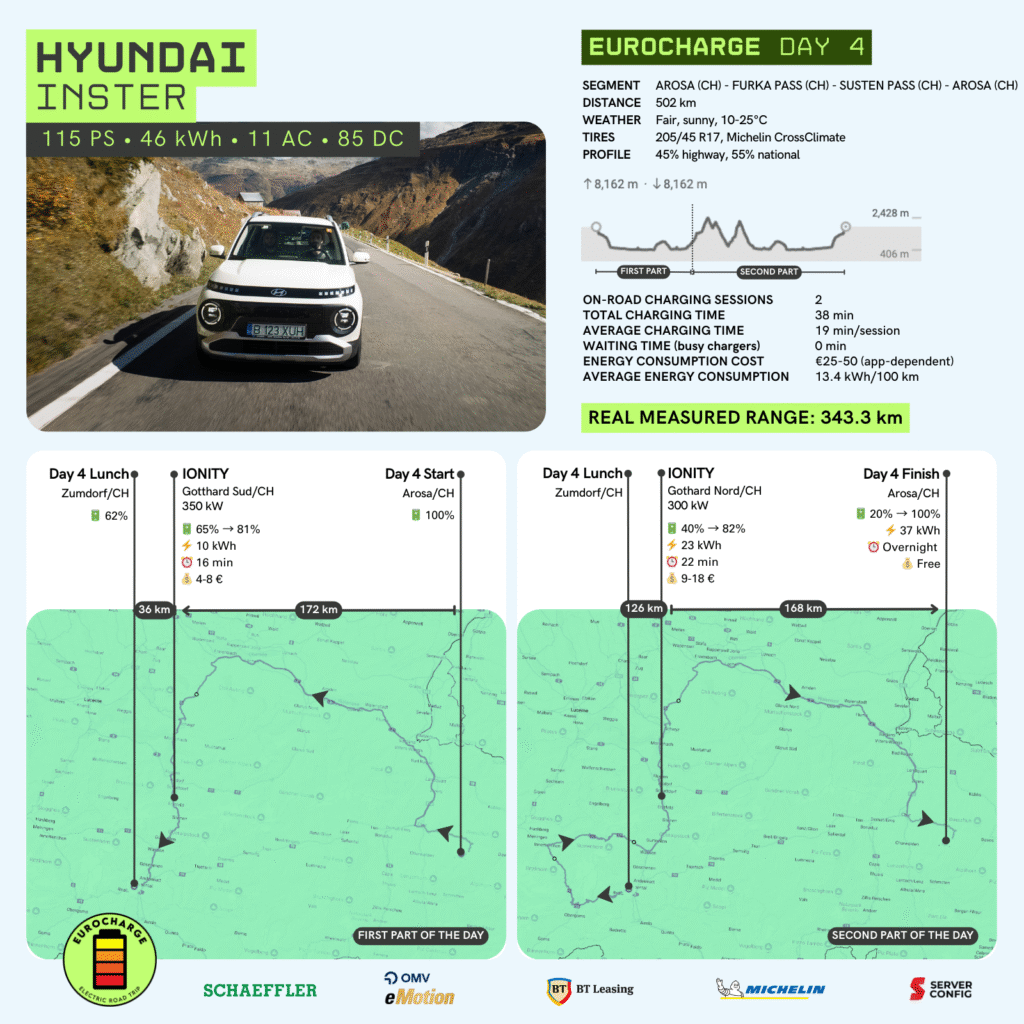
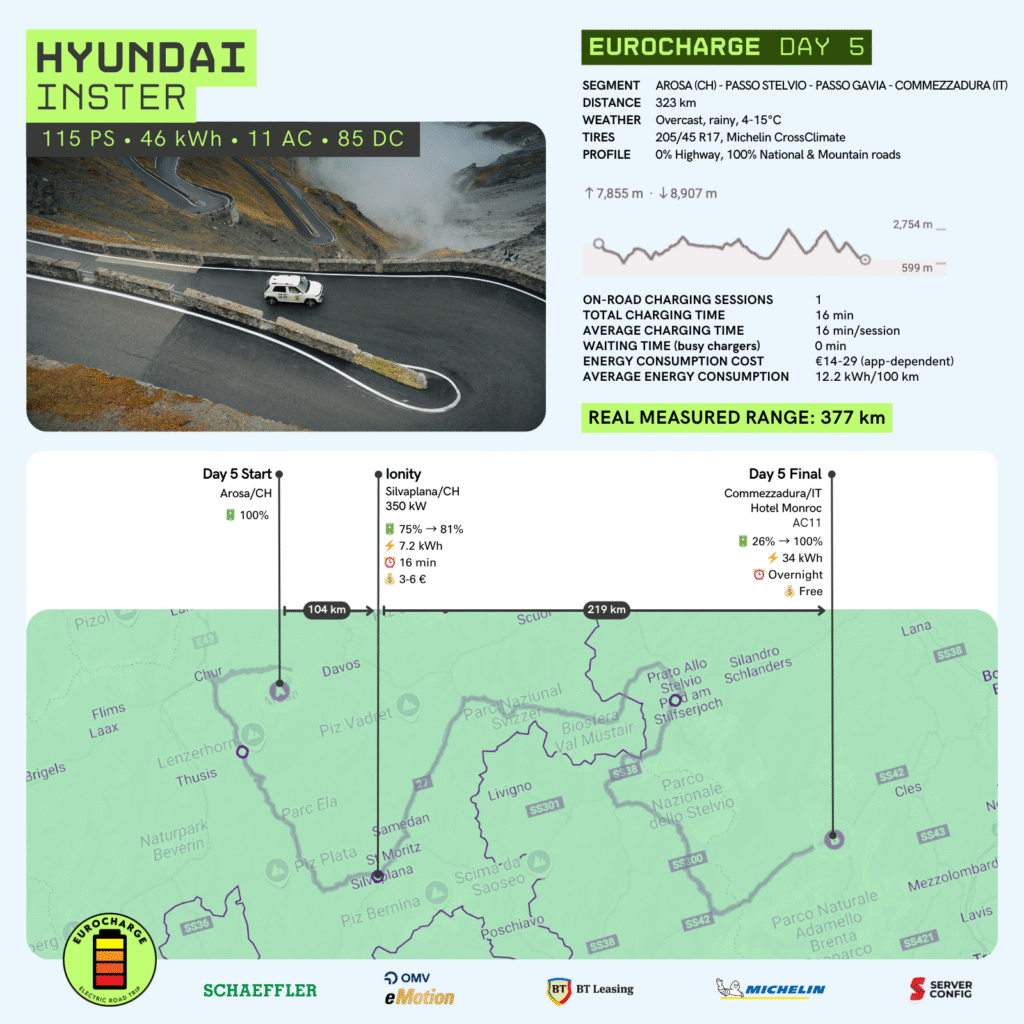
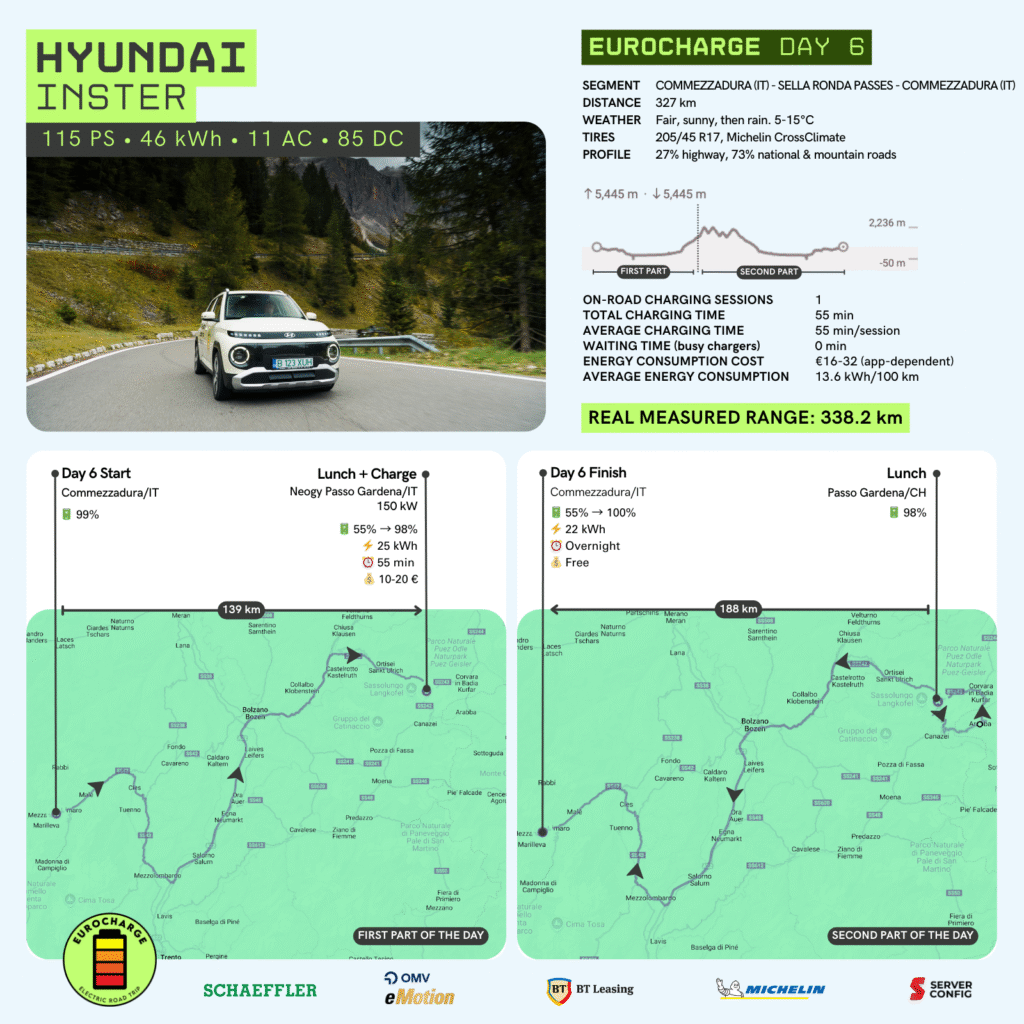
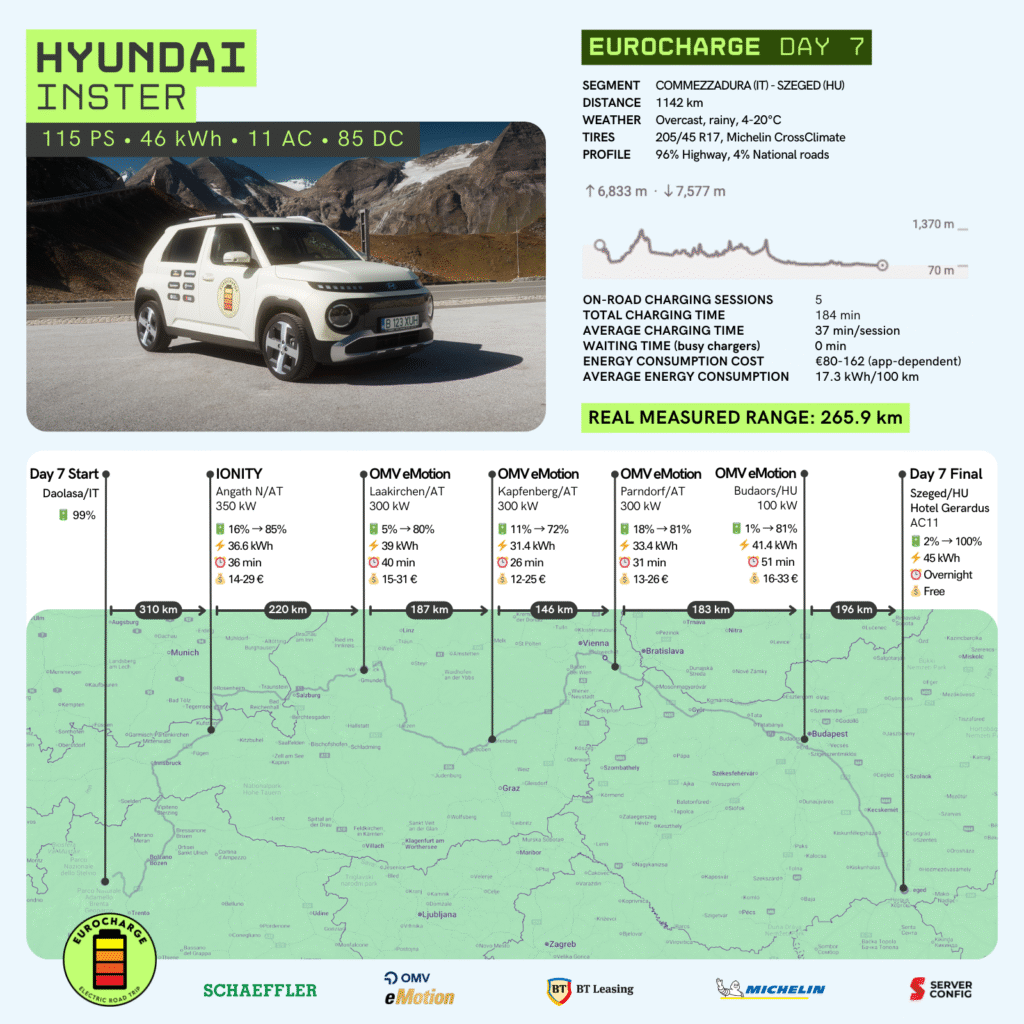
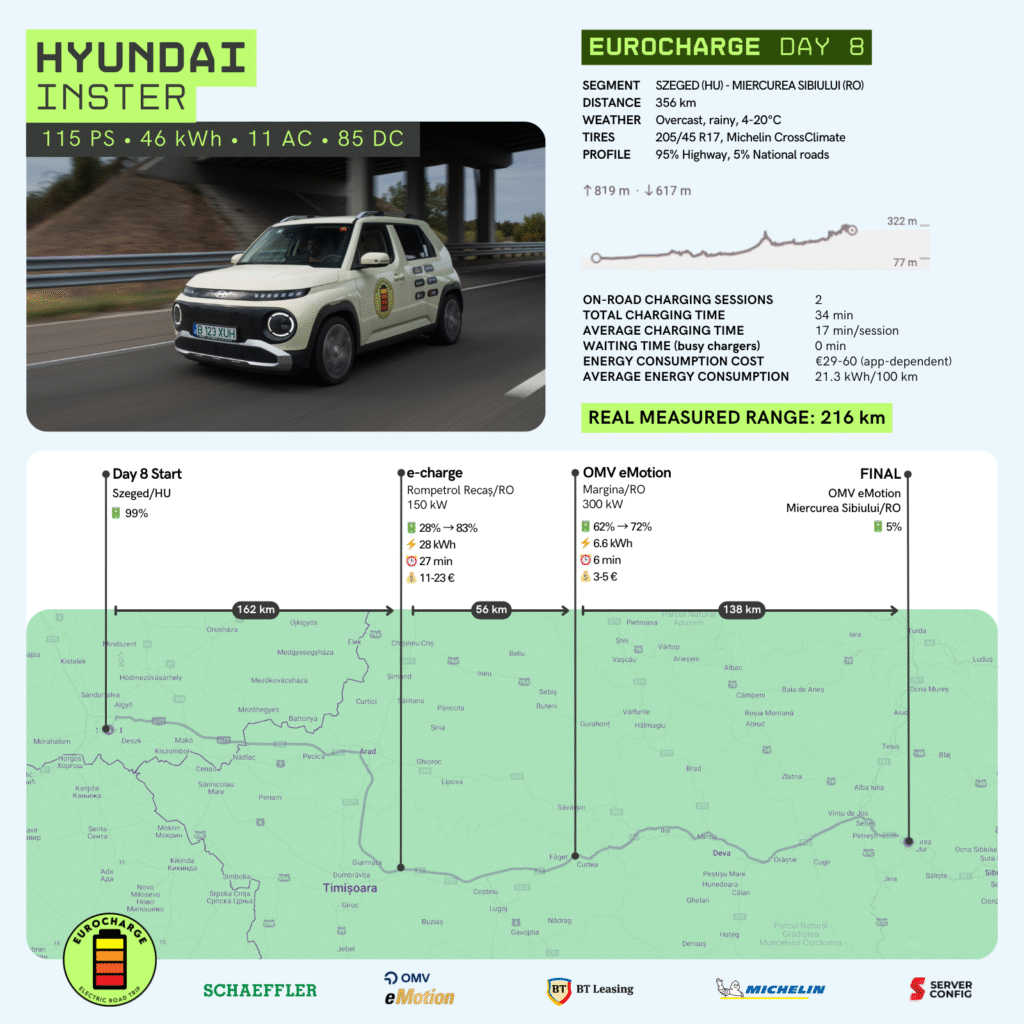
Hyundai Inster by the numbers:
- Total distance traveled: 4593 km
- Total charging stops: 21 sessions on the road + 6 overnight charges
- Total time spent while charging on the road: 11 hours and 47 minutes (707 minutes)
- Total energy charged: 793.1 kWh, of which 213.6 kWh in hotels
- Total cost of charges (hotel charges were free): between €226 and €457.8 (depending on the app used)
- Fuel cost comparison (estimated per route):
- A gasoline car of similar class (average fuel consumption est. 6.5 L/100 km, average price €1.80/L) would have generated costs of about €537.2.
- Weighted average of the energy consumption over the whole route: 16.3 kWh/100 km
- Weighted real average range: 287.9 km
Important mention on the driving style: Throughout the entire test, the car was driven in “Normal” mode, never “Eco”. It drove steadily, within the speed limits, with an approach as close as possible to the legal speed limit on each road segment.
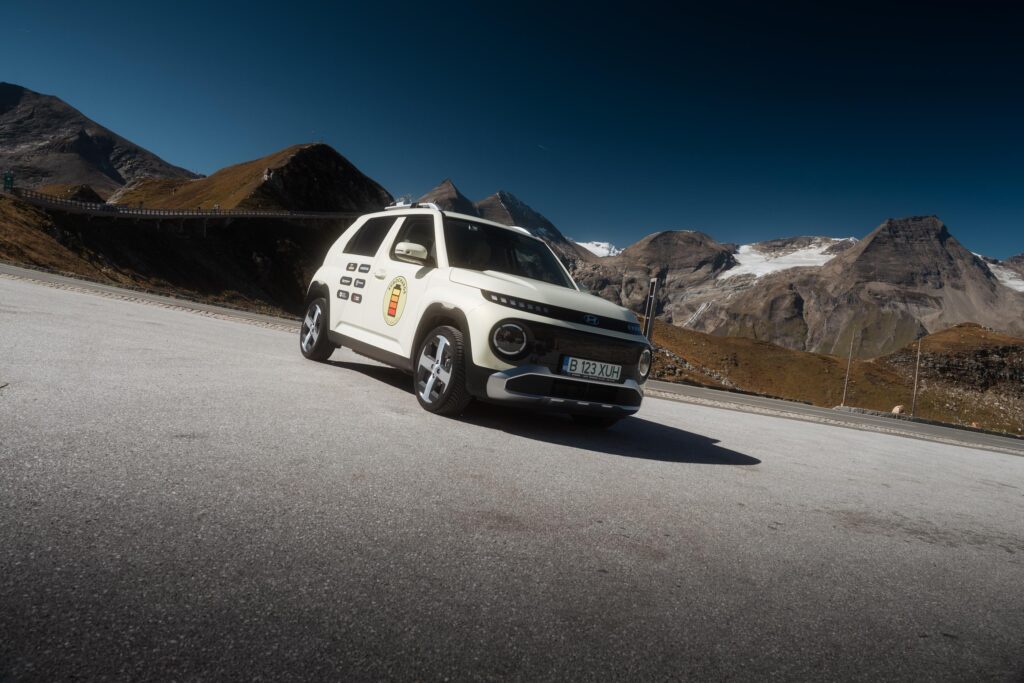
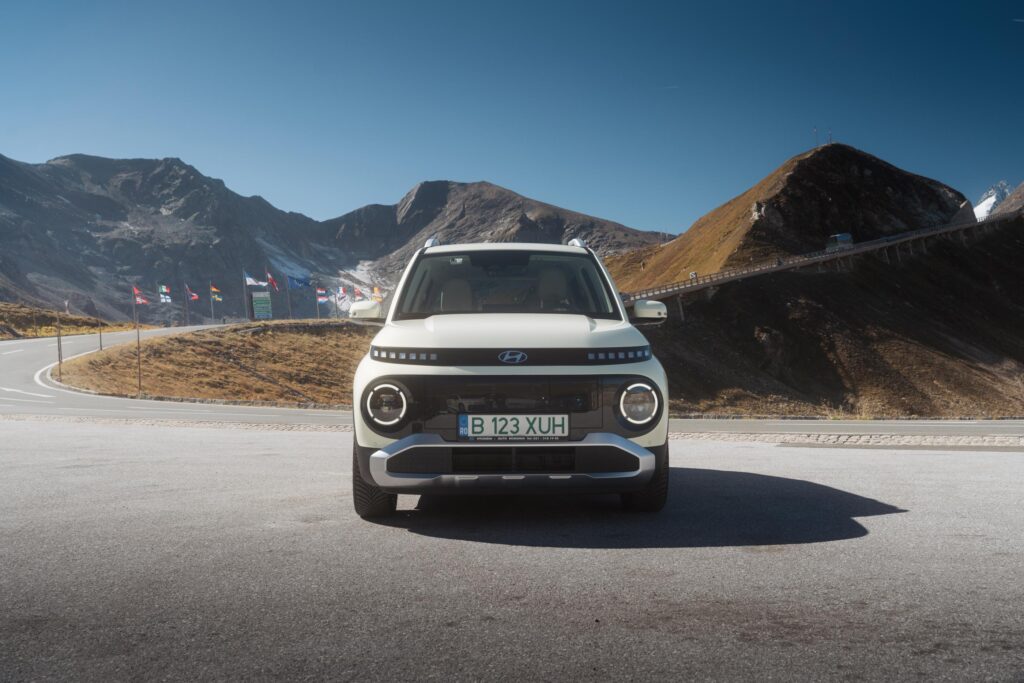
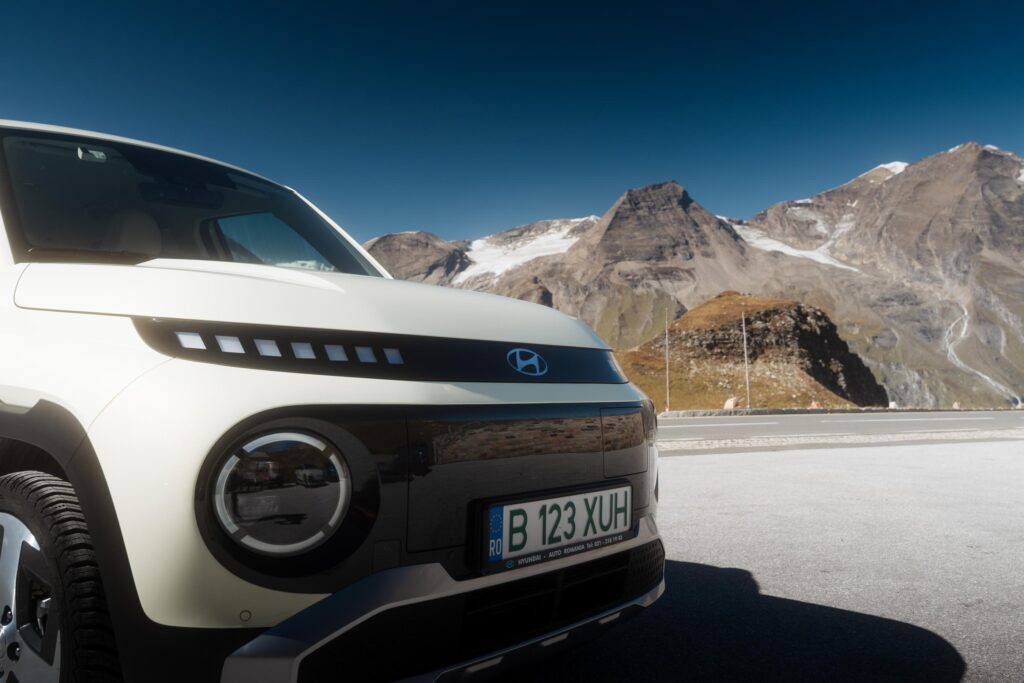
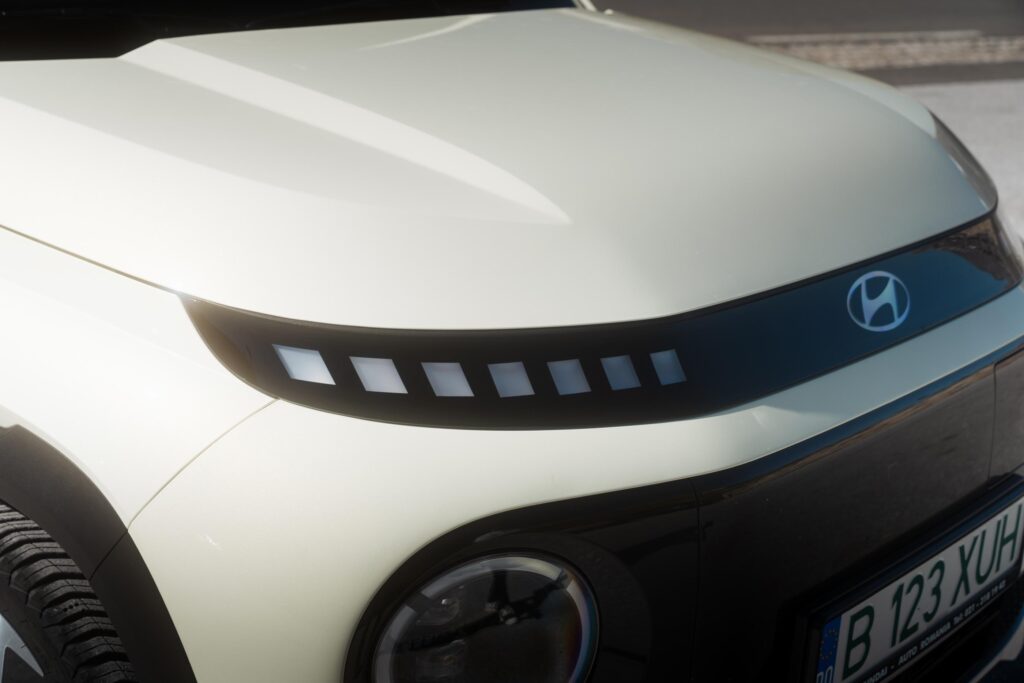
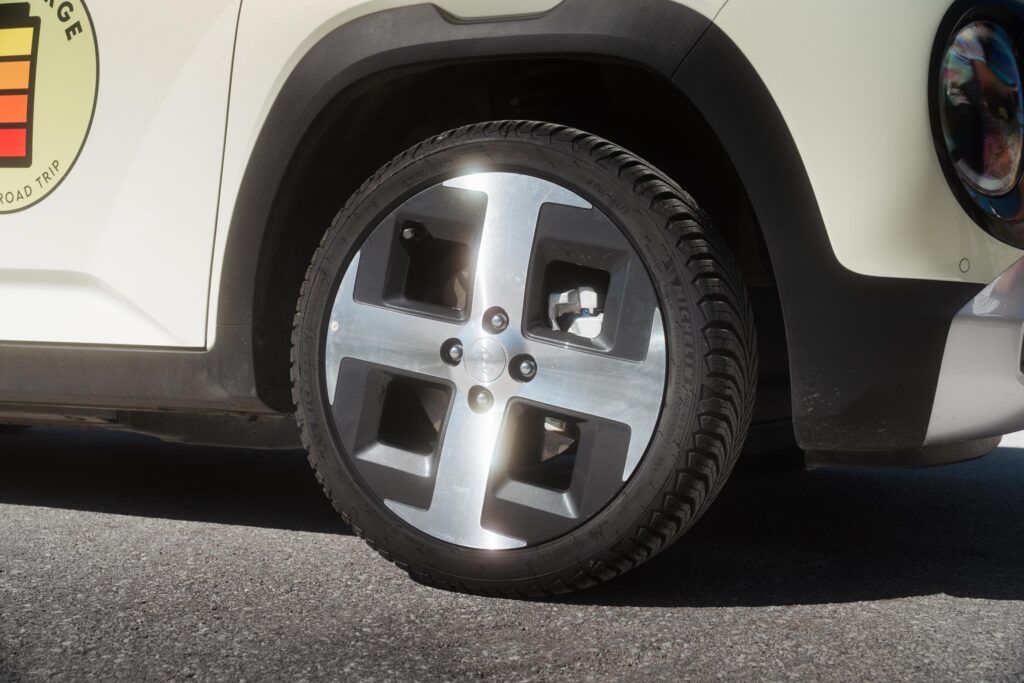
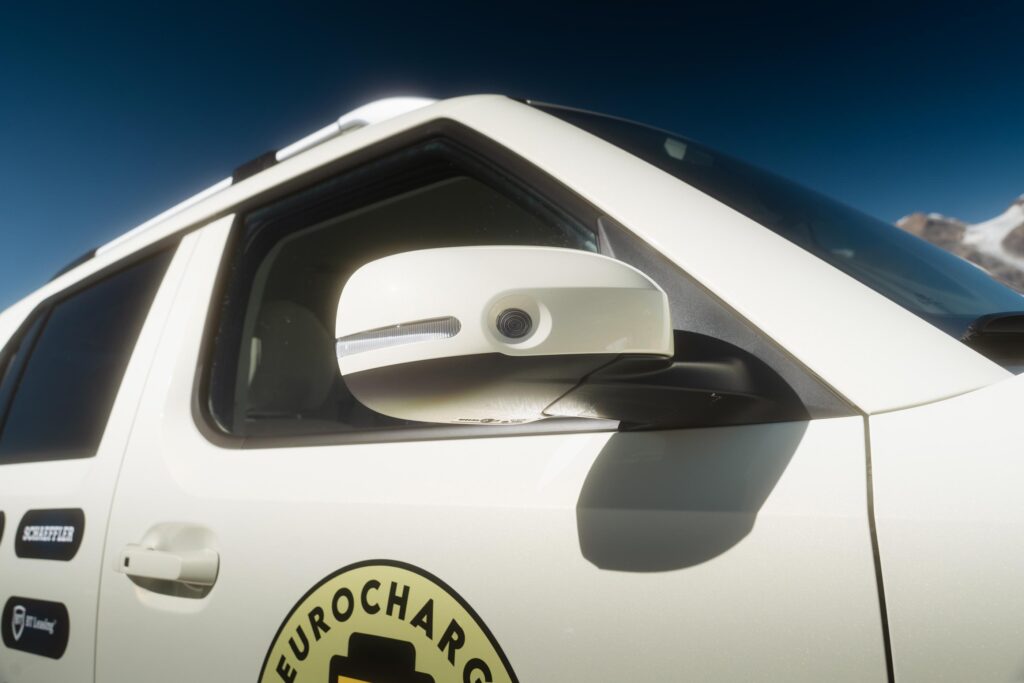
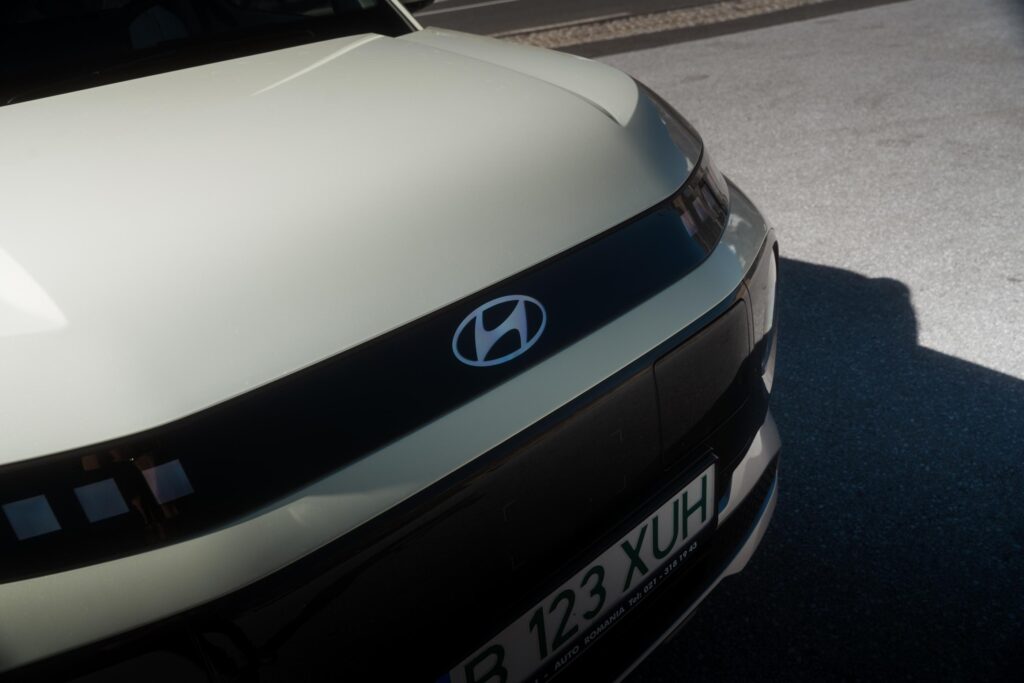
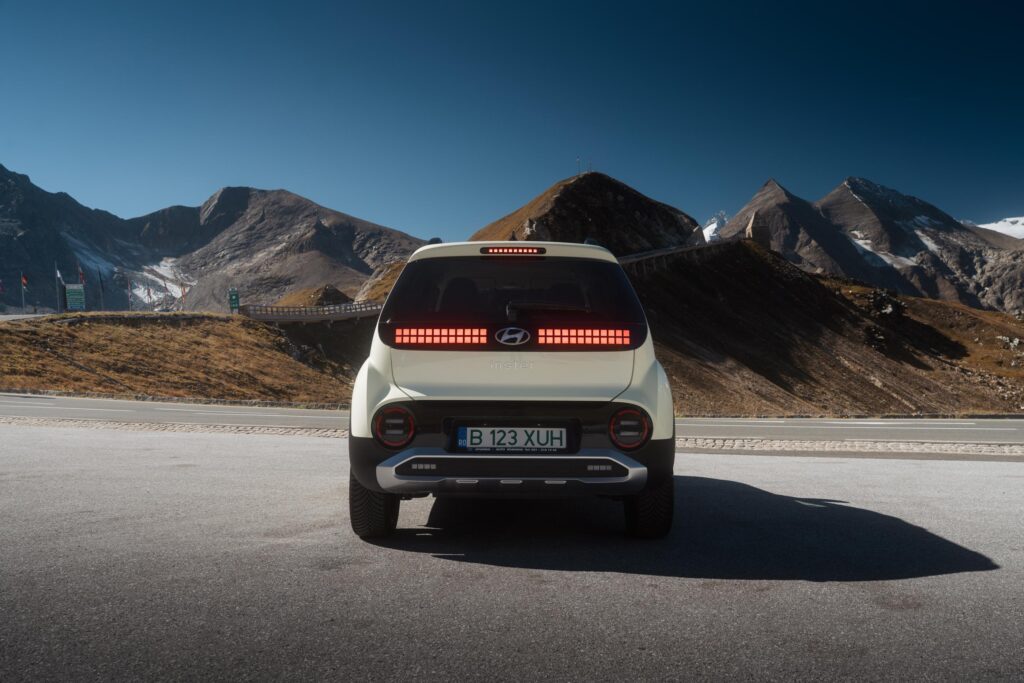
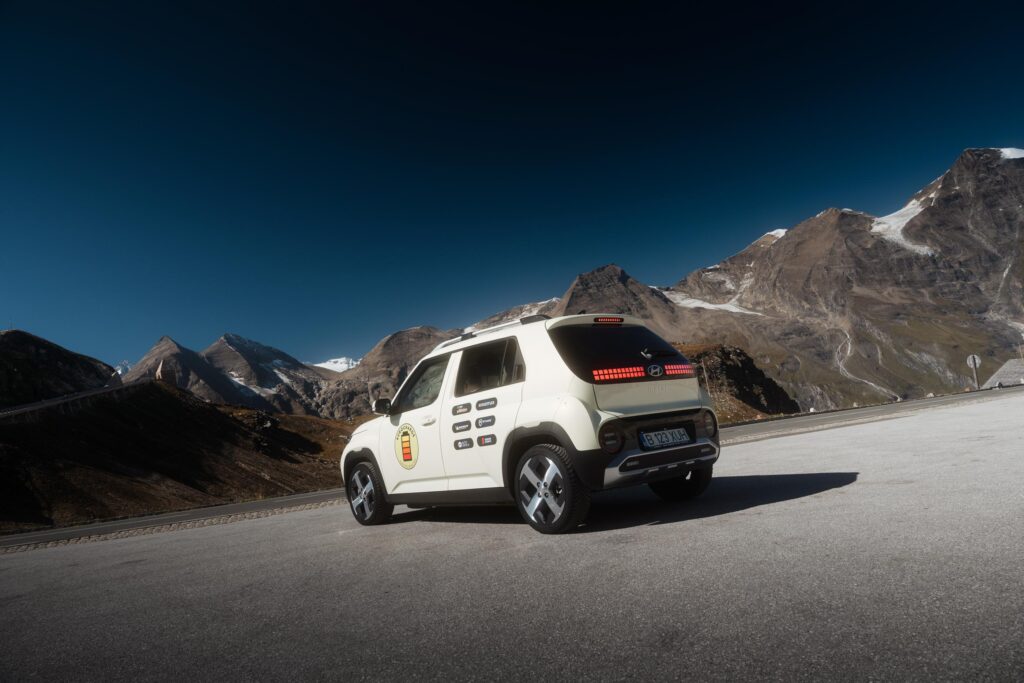
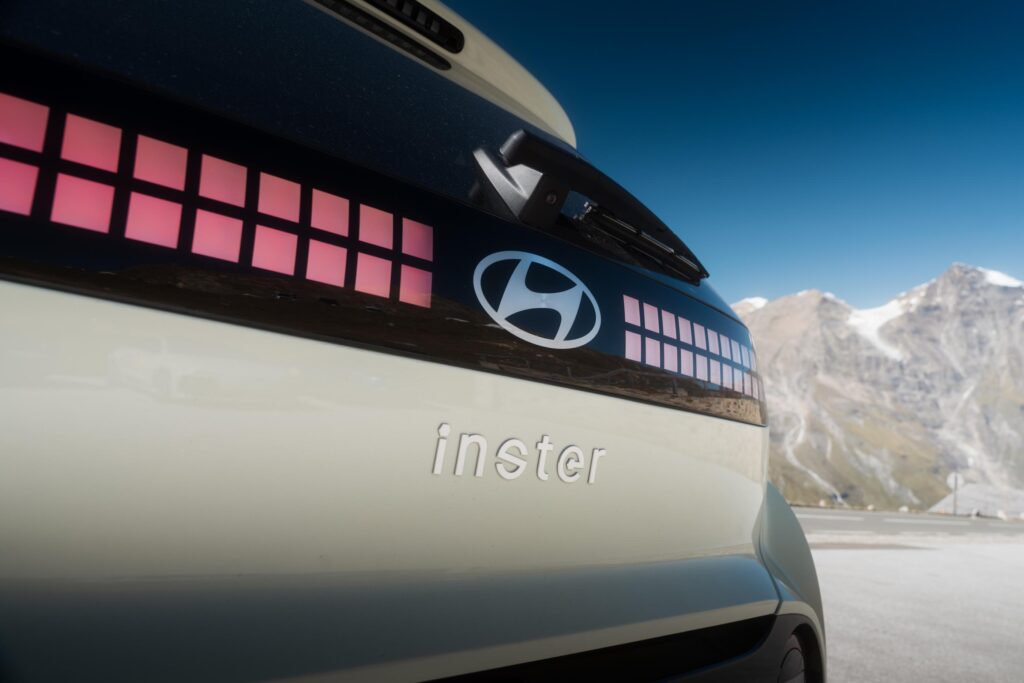
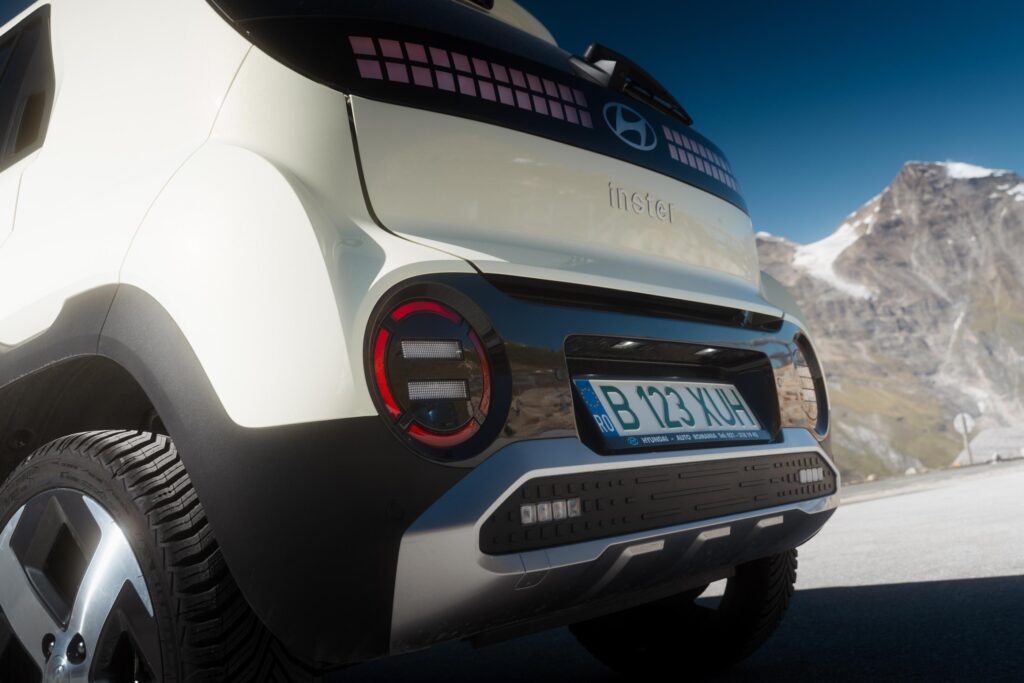
Conclusions and observations
- Efficiency champion: the Inster was the most economical car of this project. On days with alpine passes, it achieved very good fuel economy figures(12.2, 13.4, 13.6, 13.6, 14.5 kWh/100 km).
- The “Oven” strategy: With the smallest battery pack (46 kWh usable), the Inster required the most charging stops (21 in total). However, the average charging time was reasonable (33.7 min), as the small battery replenishes relatively quickly. On the highway, it required careful planning with frequent stops.
- The highway is its kryptonite: Inster’s very good efficiency on mountain roads takes a hit on the highway, where consumption increases significantly, reaching up to 21.3 kWh/100 km on the last day.
- Range fit for its purpose: The average real range of around 300 km is a fair and relevant figure for a car with an under-50 kWh battery and urban inclinations. The 377 km peak range, attained on the day we crossed the Stelvio Pass, shows the car’s full potential under ideal braking energy recovery conditions.
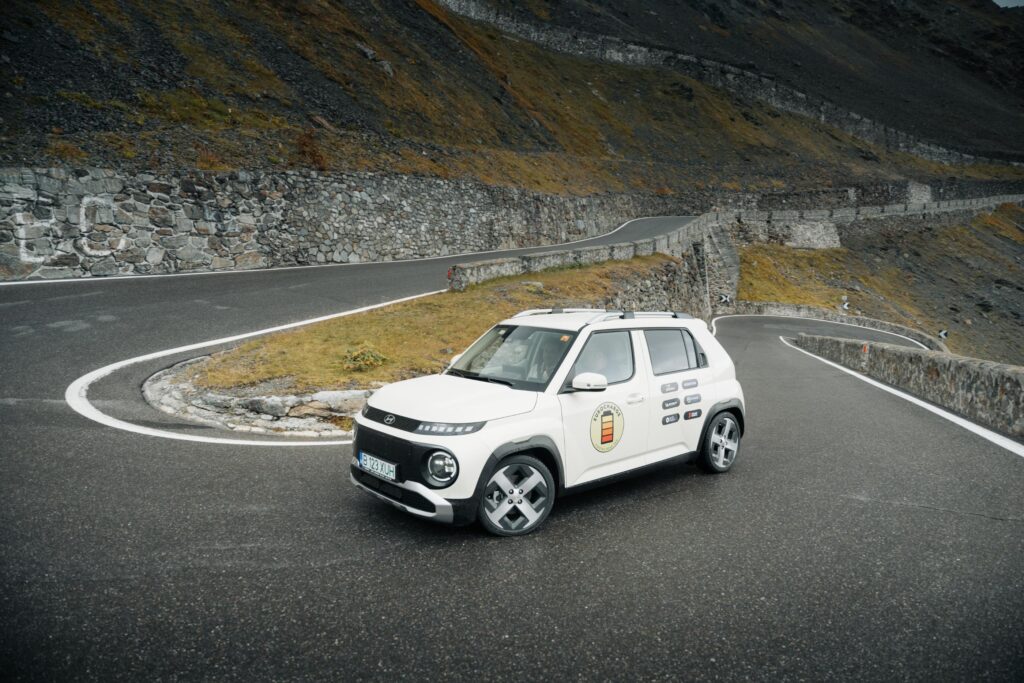
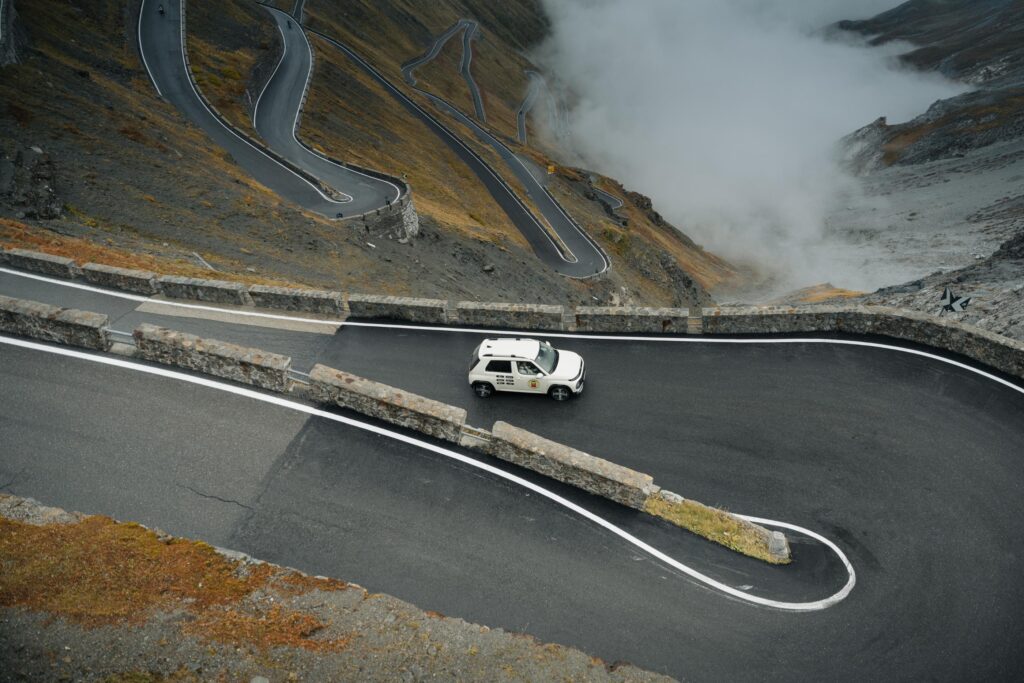
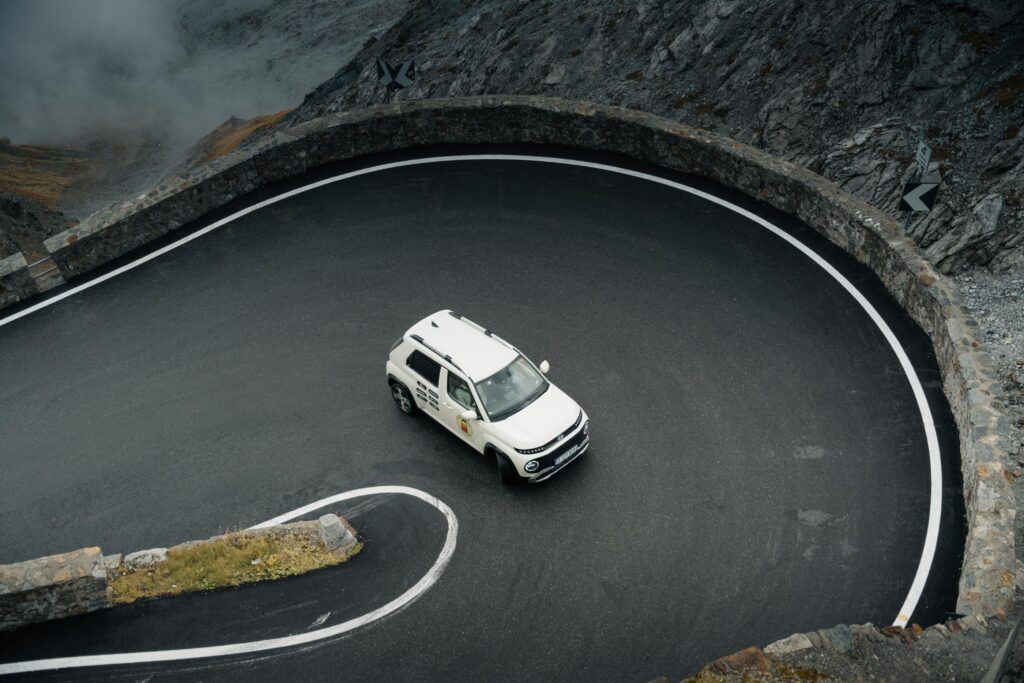
Impressions of those who drove the Hyundai Inster in EUROCHARGE by Schaeffler
Dragoș Băltățeanu (Autocritica, Auto Test)
The smallest model in EUROCHARGE by Schaeffler 2025 is the Hyundai Inster. Although it’s basically a city car, the Inster has proven itself to be a complete automobile today. It can run without any problems at highway speeds, and its energy consumption has remained within decent limits (around 18 kWh/100 km).
Depending on driving pace, range revolves around the 300-kilometer mark. The Inster kept up the pace at 130 km/h with no issues, and the car’s stability is impressive, especially since the suspension is tuned for comfort. The only minus would be that the front seats are too narrow.
Despite its small exterior dimensions, the Inster feels like a higher-class car inside thanks to the tall roof. There’s plenty of storage space, and the two rear sliding seats are a great idea. You can free up luggage space or legroom for passengers as needed.
The Inster has a tall silhouette reminiscent of the Hyundai i10 (produced between 2008 and 2015), and the design is inspired by the brand’s current styling with an emphasis on oversized, pixelated turn signals and taillights. The small EV from South Korea doesn’t use the e-GMP 800 V architecture of its bigger siblings in the Ioniq family, but has instead been developed on the K1 BEV platform.
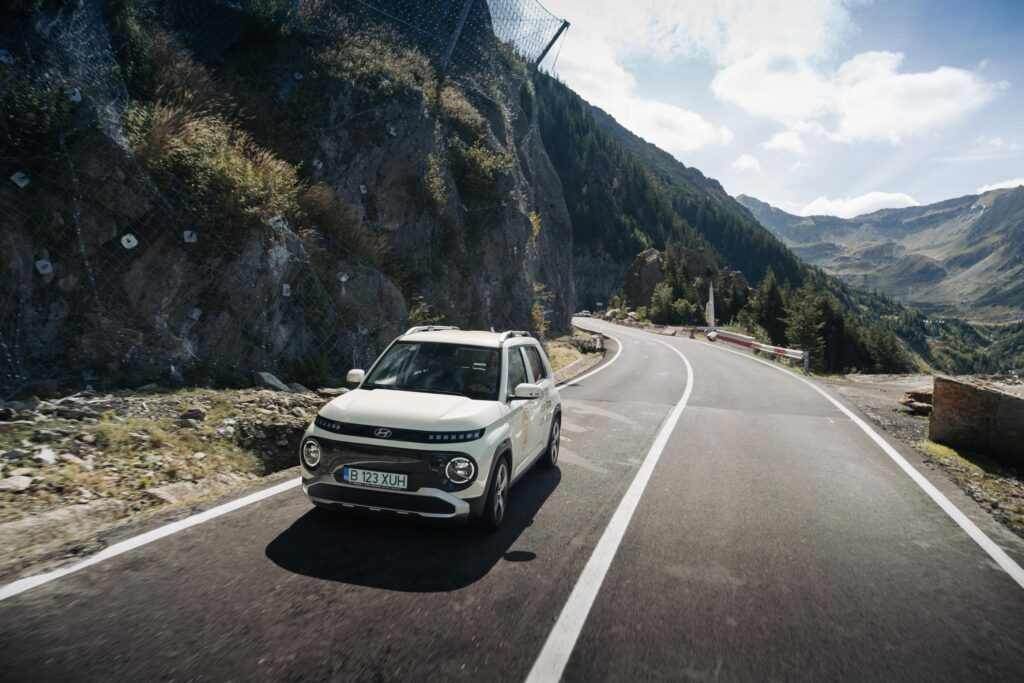
Dan Scarlat (TopGear Romania)
As it’s customary in the automotive industry, Hyundai has also set out to answer the question: what is the optimal balance between form and function? And, with the help of the Inster, it has succeeded quite convincingly.
I can’t say a bad word about design. Frankly, as subjective as this topic may be, you can’t help but appreciate the effort. You may not necessarily be a fan of curvy shapes on absolutely any body panel, but you couldn’t say that the Inster is in any way boring, either. It has a big toy attitude and most importanty, all the styling details work very well together.
As for function, well, despite its small size, this little car proves incredibly practical. Interior space is utilized to the maximum: the bench seat slides back and forth, the front seat backs can be folded down to create a sleeping area, and there’s generally enough room for four adults to travel comfortably – at least if they don’t take too much luggage with them.
There were only two of us and, with the seat folded down, we had no problem carrying my colleague’s wardrobe (he insists on calling it a trolley), but more importantly, after more than 600 km on the second day of Eurocharge, we arrived at the hotel without feeling drained of energy or with a stiff back. And the atmosphere on board greets you with that dose of playfulness you expect from a small car: bright colors, playful shapes, but surprisingly ergonomic.
You’d think it’s a big car, good enough to drive everywhere. But no, the Inster is an A-segment model, dedicated mainly to urban use and only rarely to out-of-town exploration. The fact that it’s a very small car also means extremely limited battery space. And the tall body, in which two 1.9-metre-tall passengers can wear hats, doesn’t go well with the idea of aerodynamics, and hence highway speeds.
No, the Inster isn’t noisy at 130 km/g, but it burns through its 46-kWh battery much faster there than it does squeezing through SUVs in the city. On the second day of the tour, the average energy constumption was 17.3 kWh/100 km, which in turn offers a real-life range of 266 km. So the smallest car on the tour isn’t exactly the best car for touring the Alps. But if asked, it’ll do that too.
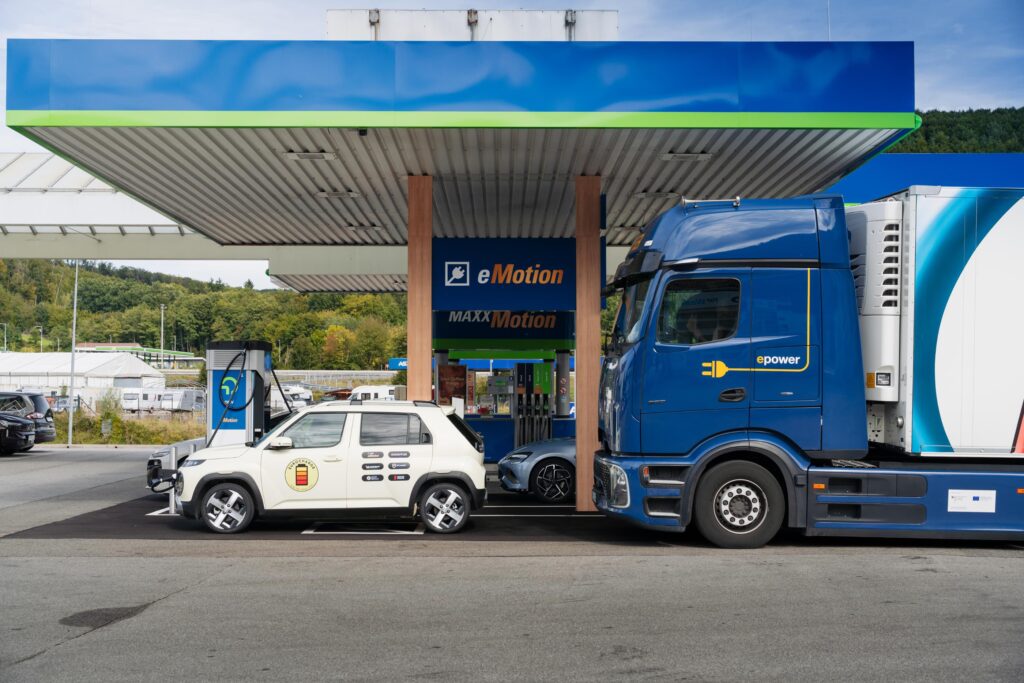
Tibi Buzdugan (Electromobilitate.com)
Since the Inster was launched I’ve been very curious about how the car feels to drive. After driving around in Dacia Spring and seeing them all over the streets of Bucharest, the emergence of a competitor that actually looks modern and doesn’t give you the impression that the only thing that was taken into account during the design was cost efficiency is welcome.
Sure, you don’t find wood, leather, merino or other crazy stuff inside, but what you do find is pleasantly colorful and gives you a sense of well-being. In the case of the model we had, the interior is very brightly colored, complemented by a checkered textile upholstery. Contrary to the ‘city car’ characterization, on our first day of alpine passes, it acquitted itself well. Even more than that, we really enjoyed the twisty roads.
In Sport mode, there’s enough torque and zip up to 80-100 km/h that you don’t feel in any way that the car is limiting you. Maybe only in overtaking big cars do you hesitate a bit, as you know it takes longer than a more powerful car, but I’d say it feels equivalent to a car with a thermal engine with at least twice the horsepower. And the very low center of gravity makes the car extremely stable and predictable in corners, although the narrow width doesn’t help it.
What you see when you sit in the front seats is not at all what you’d expect from a small class car (I didn’t say cheap, because no new car is cheap these days): the infotainment system has two screens with very good resolution, you’ve got adaptive cruise control with highway assist (in addition to distance to the car in front, speed and lane keeping, it recognizes speed limits and automatically adapts speed), you’ve got heated seats and steering wheel, you’ve got wireless phone charging, pretty much everything you’ve got on the bigger siblings in the Hyundai range (Kona, Ioniq or Tucson/Santa Fe if you’re referring to the heat-engined cars).
The only thing it doesn’t excel at is going 130 km/h on the highway and carrying more than 2 people or IKEA furniture. For someone who doesn’t need that (usually), I’d say it’s a sufficient and very efficient car.
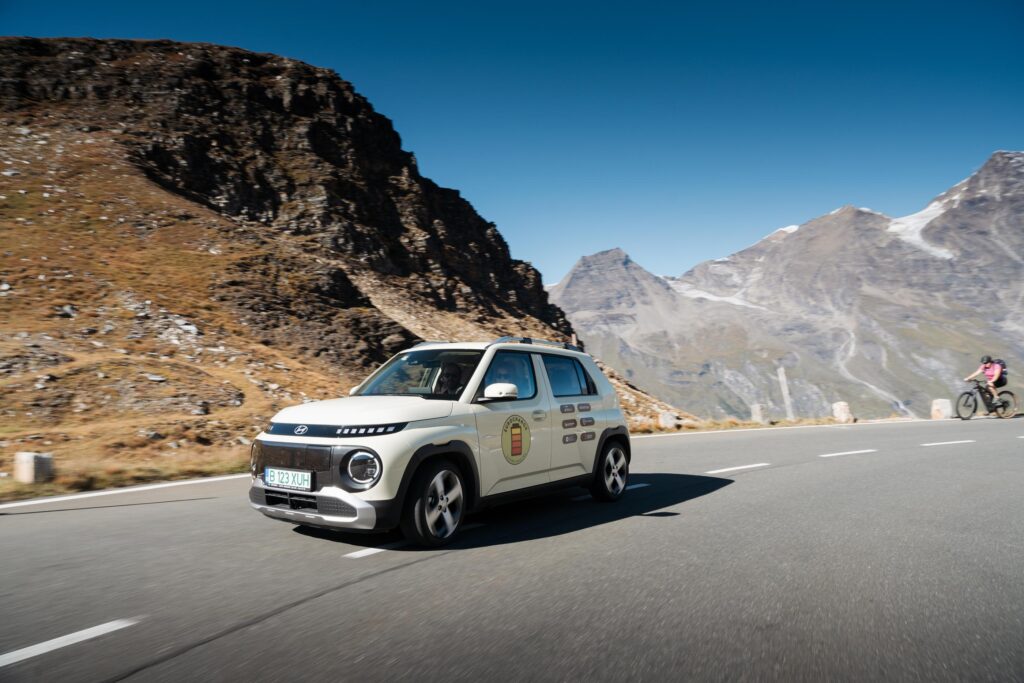
Andrei Nedelea (InsideEVs.com)
Looking at the Hyundai Inster, I get a feeling of joy. The car doesn’t try to be aggressive, it doesn’t tempt you with sharp angles, it looks like it wants you to be happy. Eyes on the windshield would be missing and it would be a character from Cars. But the unusually proportioned and detailed body conceals a surprisingly good mechanicals and specs.
It’s the car with the smallest battery in the Eurocharge 2025, a 49 kWh total capacity battery that allows it to go about 350 kilometers on a full tank. On tour days when motorways dominated, the Inster had to stop more often than the other cars to charge, but today when it climbed the Großglockner Hochalpenstraße, a spectacular pass that passes 2,500 meters altitude, the shorter range didn’t matter.
It was a revelation in the corners, with surprisingly communicative steering, well controlled roll and enough torque to get out of corners surprisingly spirited. I wasn’t expecting it to be a fun car on a twisty road, but it managed to make me smile. It’s clearly not a car designed for a sporty driving style and yet it handled admirably, confirming, if proof were needed, that Hyundai is a manufacturer that puts a lot of know-how behind all of its models, even the smallest.
And I found more to smile about in the Inster. The interior is surprisingly spacious for a car with a 2.58-meter wheelbase. Somehow Hyundai has managed to make the cabin feel big. The feeling of spaciousness is largely due to the fact that the roof is very high and you have a lot of headroom, which makes the whole interior feel bigger. It’s just like a studio flat in an inter-war apartment block with a high ceiling, which doesn’t give you the same feeling of claustrophobia that you get in a 1960s apartment block with the same floor space, but much lower.
Not only do I have backseat room behind me with the driver’s seat in my driving position-I’m 6’6″ and hold the seat pretty far back, but the knee room was remarkable for such a beast on wheels. We also somehow managed to squeeze two large suitcases into the Inster’s trunk. We could have slid the seat forward to get even more trunk space, but we didn’t have to.
I started the day driving below 80 km/h (urban and national roads) and the consumption was below 10 kWh/100 km, but it increased to over 26 kWh/100 km when I reached the highest point on the Großglockner. Then on the descent using the paddles to modulate the regenerative braking I didn’t use the brakes very much and reduced the consumption considerably, which stabilized at 17 kWh/100 km and by the time I reached the hotel in the evening the consumption had dropped to 14.5 kWh/100 km, which is absolutely respectable considering that I was doing a lot of highway driving at over 100 km/h and that the last 20 km was a climb worthy of a coastal speed stage.
I can’t fail to mention how well the Inster charged today. Connected to a 300 kW charger that it shared with the BYD Seal, it charged at a steady 80 kW, and even when it was around 70%, it was still pulling over 70 kW from the station. A very good charging curve for a car whose maximum charging power is 85 kW. All in all, I liked the Inster and it showed me that it’s not a problem to take such a small electric car out for a long drive. You don’t need to drive it slower, below the speed limit on the highway, and you can cover hundreds of kilometers without any problems.
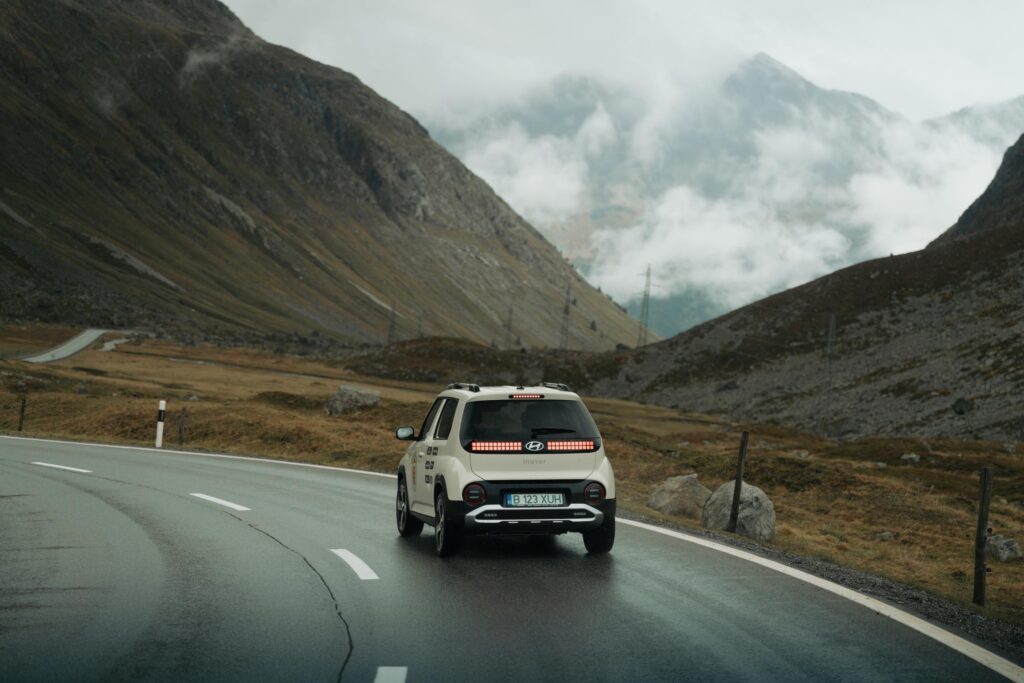
Cornel Șocariciu (Autocritica)
A car, regardless of the purpose for which it was developed, should be able to outdo itself and perform, sometimes even in less than favorable scenarios. We’ve seen record-breaking SUVs at the Nurburgring, but we’ve also seen electrics that have ridden to the ends of the earth and back. Therefore, I don’t think a Hyundai Inster on the Furka Pass should raise eyebrows any more. Be honest, on your vacations, how many times have you not encountered small or subcompact cars that carried their “masters” with ease?
For me, the Inster is no surprise. The Asian manufacturer needed a representative in the small-mini area, and with the experience gained from the Kona and Ioniq projects, Hyundai couldn’t do much wrong. Strengths? Efficiency: the car is light and manages to make diligent use of every kWh of energy, resulting in a good level of efficiency and a decent range for the battery capacity. For those who still doubt our experiments, I’ll tell you this: there wasn’t a moment that I thought about range or the rest of the battery. I enjoyed the alpine passes in Switzerland, period.
Then there’s space. In general, models in this segment might scare off those suffering from claustrophobia. Not the Inster. The crossover shape (slightly atypical for its segment) and the large windows manage to add to the atmosphere inside. Of course, the minuses come when elbows with your tour-mate get annoying or knees don’t find the most relaxed position.
Also in the plusses, I’d also include the dashboard transplant from the bigger Ioniq siblings. Obviously, elements were lost during the operation, but the perceived quality is not to be neglected. The rest of the interior, on the other hand, is exactly as you’d expect it to be: lots of plastic (but with good textures) and door fronts that could have done with a bit more sound-absorbing material. If I’m allowed one more tug of the sleeve: the steering wheel seems oversized for the Inster’s interior.
I’ve saved for last the cherry on top of the cake I envisioned: the pepita upholstery. Not only do I like it, but I’d give an idea to car manufacturers: let them sell in furniture stores the seats they put in their cars (adapted, obviously, to a different use). Because if that were the case, tomorrow I’d get two just like the ones on the Insterul in EUROCHARGE.
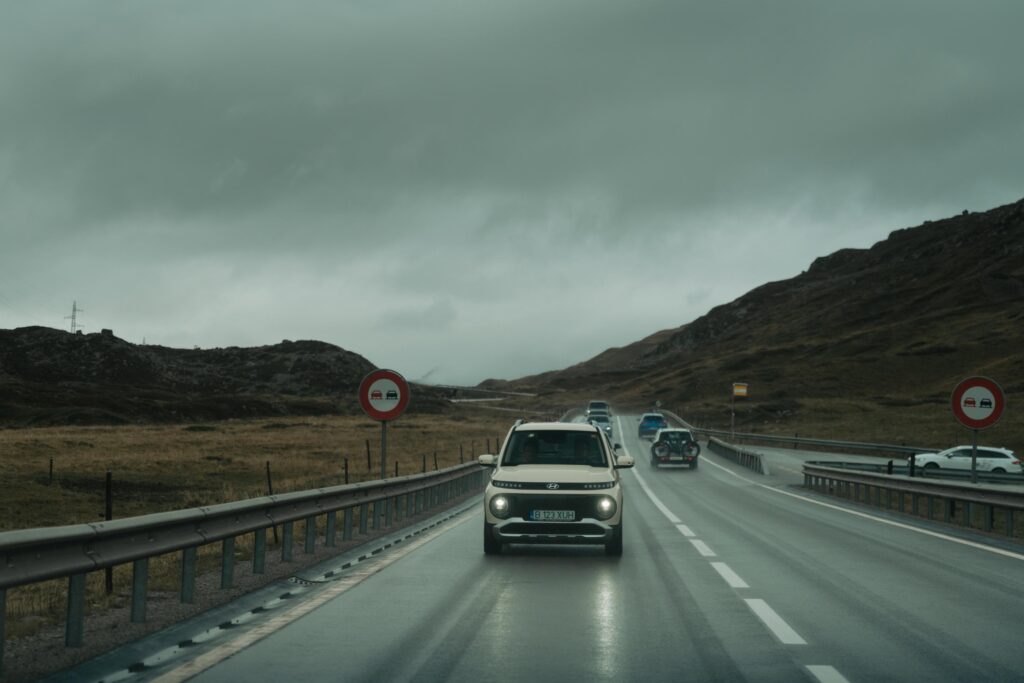
Marco Badea (Explicativ.com)
The Hyundai Inster is the little brother of the family. Although it’s the car with the smallest battery, today it did very well on Passo dello Stelvio and Passo Gavia. At the end of the day I got a fuel consumption of 12.2 kWh/100 km, after almost 323 kilometers from Switzerland to Italy.
At first glance it looks like a small car, but inside it’s very well designed. In addition to the bright, party-in-the-car colors and the “Sarà perché ti amo” and “Grande Amore”, the space is adjusted to suit different sizes, the dashboard is intuitive, although the infotainment system is slower than the rest of the cars on the tour, and the straighter windshield and large rear window make for a better ride quality. Plus, it’s also a sign that from the inside the car isn’t as small as it looks on the outside.
The Hyundai Inster is easy to drive because it stays on the road well, it’s not at all unstable in corners, climbs smoothly and feels powerful when you need it. It’s a car that’s built for the city, but it can pull with you on the long haul if you know how to time your loads.
I enjoyed driving the Inster. It suits the mood when you enter Italy, because it’s a car that makes you feel friendly. It doesn’t want to intimidate you, it doesn’t want to charm you or literally scare you. It’s a car that passes you or catches up with you at the traffic lights and just seems to want to greet you in a friendly, camaraderie on the road.
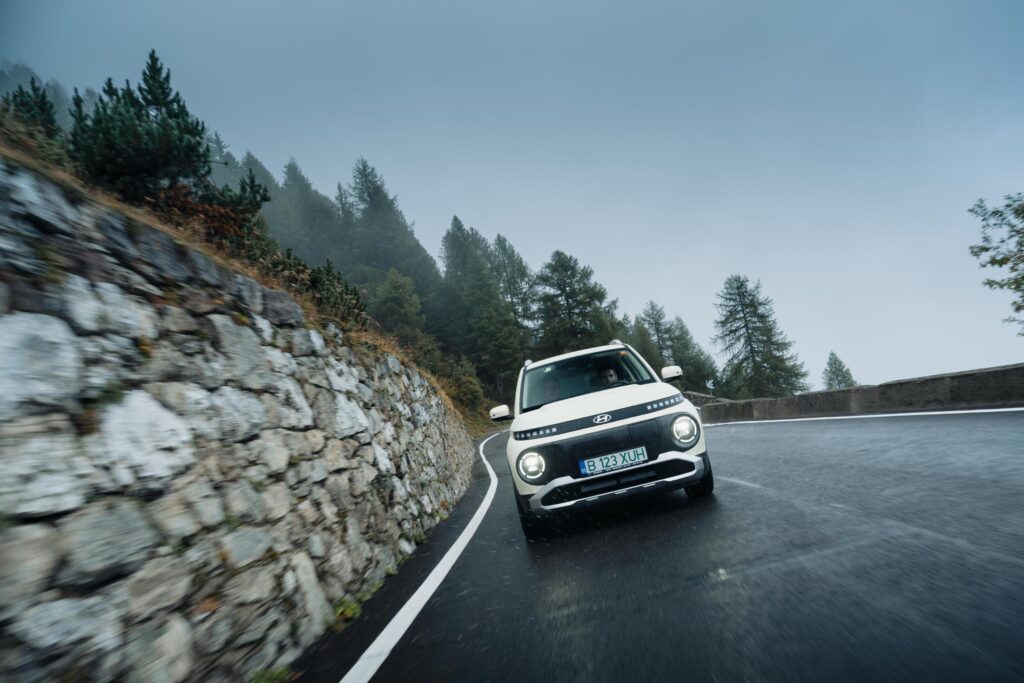
Mircea Mester (Autocritica)
On the highway, the first surprise came. Yes, it charges slowly, but on the other hand, the battery’s small. On the clock, the Inter doesn’t take much longer to charge than the rest. It kept up, even though it racked up more charges than the others when I counted them in the daily infographic reports.
But the real revelation came in the Alps. On those narrow, winding roads in the Dolomites, the Inster was transformed. It became the most maneuverable and fun car on the whole tour. It’s small, agile and has a low center of gravity. You slip past anything, anytime, anyhow, and parking is child’s play. The Inster is a kind of modern-day Daewoo Matiz, a car that’s conceptually exceptional (small and roomy), but modern and gives you all the technological comforts of 2025. It’s like a go-cart, but with a raised roof, air conditioning and a boot that actually exists.
And then we compiled the figures. Yesterday, in the Dolomites, after 320 kilometers that included the Sella Ronda loop and highway at legal speeds (on the way from the hotel to the mountains and back), the consumption was 13.6 kWh/100 km. A truly absurd figure. And it could have been even lower – take it off the highway and leave it in its natural habitat – city, country, mountain roads – and this car becomes a stellar performer in terms of efficiency. It’s what Hyundai did on the Kona, but scaled proportionately down a segment even further.
Inside, the Inster is an exercise in intelligence. Although it’s the size of a bedside table on the outside, the interior design is fabulous. The ceiling is high, and the dashboard is full of crevices and storage spaces. No other car on the tour comes close to the ingenuity with which the Inter’s space is designed. Okay, obviously, it’s all plastic. Honest, well-assembled plastic, but still hard plastic. Let’s not kid ourselves. But to add to the irony, the steering wheel and the levers behind it are taken straight from the Ioniq 5’s sibling, the Ioniq 6, a car three times the price.
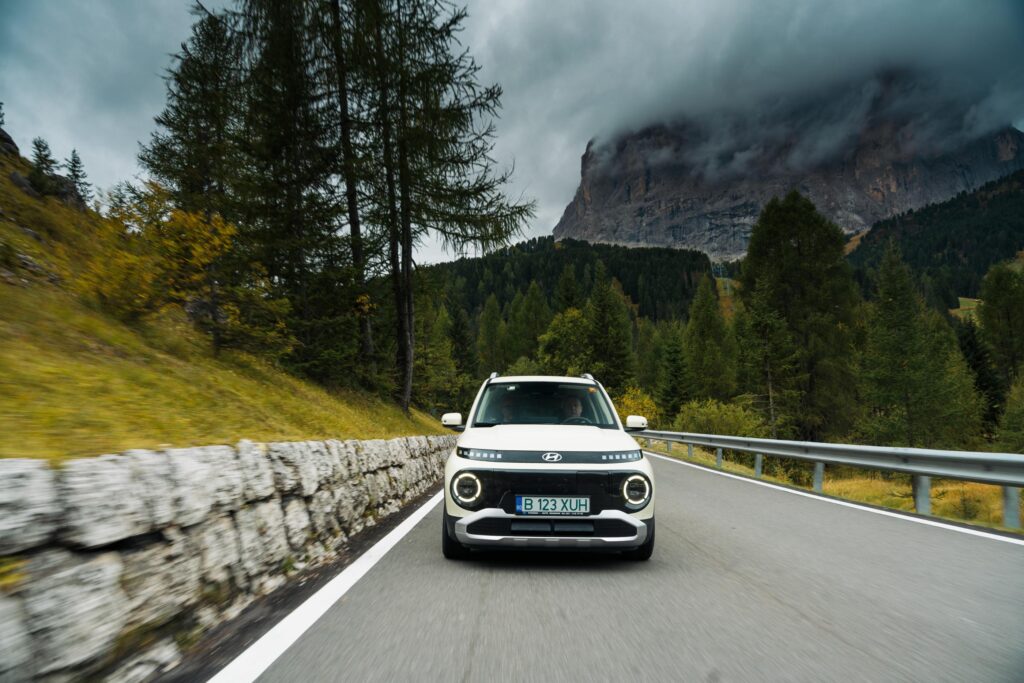
Constatin Ciobanu (Autocritica, Adevărul Auto)
So, the Inster. This car is made for the city and it’s brilliant for the urban environment. Okay, maybe I would have liked a couple of liters more in total trunk volume. I also don’t mind the fact that it can max out at 85 kW at DC stations, because in the urban environment, it will be happy with the 11 kW available at AC stations. To me the Hyundai Inster is what an electric Fiat Panda should have been.
Can you go for the long haul? Yes, but the car isn’t designed for that, and it’s not to blame for not giving you everything you want in a long-distance car.
It’s been an extreme test for the Hyundai Inster on this long day, but it passed with flying colors. And the fact that it got me to my destination without any sort of anxiety made me put it on a list of cars I like.
